#Virgin Mary of San Nicolás
Explore tagged Tumblr posts
Text
The Argentine Iron Guard
#Bergoglio and the Argentinian dictatorship#Juan Domingo Perón#Eva Perón#Father Bergoglio#Pope Francis I#Virgin Mary of San Nicolás#Anti-Pope Peter II#Argentinian Iron Guard#Massimo Introvigne
0 notes
Text

THE DESCRIPTION OF OUR LADY OF THE GOOD EVENT OF PARAÑAQUE Feast Day: August 10
The history of Our Lady of Good Event of Parañaque was based on the writings of Nicolás de San Pedro, the vicar of St. Andrew's Parish (now the Cathedral Parish of St. Andrew), written in 1700.
The Augustinian fathers brought the image from Spain in 1580 as a gift from the King to Filipino converts. The Augustinians stayed in Palanyag (now Parañaque) and established St. Andrew's Parish that year. The image was left untouched and covered with dust until Catig, a poor native from Don Galo, saw this and asked the sacristan if he could take the statue home. The sacristan obliged and Catig enshrined it in his home, lighting candles in its honour.
As Catig lay dying later on, his neighbours called the priest Juan de Guevarra to administer Last Rites. Upon blessing Catig, de Guevarra saw the statue standing near the bed and asked if he could buy it for PHP 24 (note: the peso was of higher value during the Spanish Period). Catig initially refused, but then changed his mind, knowing that it would be revered by the people. De Guevarra took the statue and placed it in his own room after Catig had died.
According to de Guevarra, he saw the image emit a mysterious light and heard glorious hymns, leading him to conclude the image as being miraculous. De Guevarra reported the miracle immediately to the Augustinian Superior Alonzo de Mentrida.
Upon hearing de Guevarra's words, de Mentrida ordered that the icon be transported to St. Andrew's church. On August 10, 1625, a great procession was held, and the image was enshrined in the altar.
Not knowing what to call the image of Virgin Mary, de Mentrida asked the other friars to write the name of all the famous titles of the Blessed Mother in Europe on strips of paper and placed them in an urn. A young child was asked to draw the name and for six consecutive times, the title 'Our Lady of Good Event' (Buen Suceso) was picked, so they named the image as such.
The fifth Archbishop of Manila, Miguel García Serrano and colonial officials based in Manila arrived and venerated the image. Serrano is credited with instituting the novena and reconstructing the altar. After the reconstruction, another feast was celebrated on February 22, 1626, attended by townsfolk and those from neighboring provinces.
St. John Paul II granted the image a decree of Canonical Coronation on 18 December 1999. The rite of coronation was executed on September 8, 2000 - the feast of the Nativity of Mary. Former president Gloria Macapagal-Arroyo attended the formal event.
Our Lady of Good Event is patroness of the Diocese of Parañaque along with Andrew the Apostle, to whom the cathedral is dedicated.
An official replica by Filipino santero artisan Thomas Joven (deceased) was blessed by Manuel Gabriel during the solemn High Mass on September 8, 2010.
In celebration of her 387th enthronement anniversary and feast day, a decree of Pope Benedict XVI, with approval of Jesse E. Mercado, the bishop of the Diocese of Parañaque, stated that the Cathedral Parish of St. Andrew would be the 'Diocesan Shrine of Nuestra Señora del Buen Suceso de Palanyag' on August 10, 2012 - the feast of St. Lawrence, deacon and martyr.
The Diocese of Parañaque declared Our Lady of Good Event of Parañaque as the official Patroness of the City of Parañaque. The Mass was attended by Parañaque City government officials and lay people on her 12th canonical coronation anniversary in 2012.
The Cathedral Parish of St. Andrew celebrates her feast on August 10. In the Spanish times, there are several feast dates honored to "Nana Ciso," as the townsfolk called her (endearment), such as February 22 (the first feast of Nana Ciso, which was approved by the Archdiocese of Manila on that same day, year 1626), months of May and October, and December 1 (from 1892 until the breakout of World War II, her feast is celebrated on December 1 following the parish's patron feast, St. Andrew the Apostle, the day before, November 30). From the end of World War II until 2004, it was celebrated on November 29, but since 2005, it is observed on August 10 to commemorate the image's 1625 enthronement and it became her official feast day.
©2022 photo by yours truly
#random stuff#catholic#feast day#marian image#our lady of the good event#our lady of good success#nuestra señora del buen suceso#paranaque#philippines
1 note
·
View note
Photo


Our Lady of the Rosary of San Nicolás is, in Catholicism, a title of veneration of the Virgin Mary associated with a reported private revelation to Gladys Quiroga de Motta, a middle-aged housewife, beginning in the 1980s in the city of San Nicolás de los Arroyos, Argentina. Quiroga said that she was tasked with promoting devotion to the Mother of God under this title, with an emphasis on key passages in the Bible and a particular mystical stellar symbolism. The devotional image, that of a standing Madonna offering rosary beads to the faithful, resembles that of Our Lady of Mount Carmel offering the scapular to St. Simon Stock, while differing from traditional Dominican Seat-of-Wisdom-type depictions of Our Lady of the Rosary popularized by the Order of Preachers.
On 25 September 1983, a mother named Gladys Quiroga de Motta, while praying the Rosary in San Nicolás de los Arroyos (Argentina), saw the Virgin Mary holding the Child Jesus. It was the first of a long series of apparitions. On 27 November Gladys saw a statue of the Virgin and Child. Later, accompanied by Father Carlos Pérez, she recognized it to be identical to the one preserved - awaiting restoration - in the bell tower of the cathedral of San Nicolás. “They have forgotten me, but I have risen”, the Virgin had told her, presenting herself as Our Lady of the Rosary. It was a wooden statue that had been blessed a century earlier by Leo XIII and donated by a woman to the Cathedral of San Nicolás, consecrated in 1884. The Virgin also indicated the place where a sanctuary was to be built, whose work was started by Bishop Domingo Salvador Castagna.
After a long period of theological investigation, the apparitions were finally recognised as having supernatural character by Bishop Héctor Cardelli. In the decree of 22 May 2016 Monsignor Cardelli explained the reasons for his decision, which was based on the perfect adherence of the messages to Catholic doctrine, the proven virtues of the visionary, and the abundant spiritual fruits (conversions, spirit of prayer and charity) generated since the beginning, 33 years earlier, of the apparitions. So he concluded: “(...) as a diocesan bishop competent for this type of pronouncement, motivated by a sense of just conscience (...) I recognise the supernatural character of the happy events by which God, through His beloved Daughter, Jesus through His Most Holy Mother, the Holy Spirit, through His beloved Bride, has lovingly manifested Himself in our Diocese”.
In her messages, the Virgin several times explicitly recalls the mission of Lourdes and Fatima and points out that turning away from God is the cause of all the evils of humanity. What she said on 15 September 1989, the day of Our Lady of Sorrows, is an example of her messages. She explained that in these times “my sorrows are: rejection of my Son, atheism, lack of charity, babies who are not born, misunderstanding in families, the great selfishness of so many children in the world, their hearts still closed to the Love of this Mother”.
The Virgin often ends her messages by indicating precise passages from the Holy Scriptures. She frequently exhorts young people not to let themselves be deceived by the Evil One and to discover God's love. “I see youths drifting away, the devil drives them away, leading them to sin”, she says on 12 December 1984. Therefore she asks “to pray for the youths of the world who have not met God. For those who behave degradingly, for those who are badly advised. The Lord can redeem them because He is merciful and loves His children” (31 January 1984). The way that Our Lady shows to everyone is “conversion to God” and “consecration to my Mother’s Heart” (9 July 1987). At other times it is Jesus who manifests Himself to Gladys, confirming the maternal mission, as on 19 November 1987, when He explains to the visionary that “souls will come to Me through Her Immaculate Heart”.
Another uncomfortable message for contemporary society is the indissoluble bond between love and the cross, which must be accepted on every earthly day in view of eternity. “The Lord has prepared, my daughter, for each one their own path. A great truth is that on every path there is a cross, and it is this same cross that must be carried with love and offered to the Lord. One does not reach God except through suffering, and even less does one come to love God if one does not recognize that it is through the cross that one will reach His Glory [...]” (19 August 1987).
Recurrent is the reminder about the real presence of Jesus in the Eucharist and the infinite value of the Holy Mass, in which Our Lady asks to participate “every day or at least once a week” (15 September 1984). The fruits will be abundant. In the Holy Mass, explains the Heavenly Mother on August 3, 1985, “you will be nourished by the Bread of Life, which is Christ Jesus. Feed on Him, no plague will come to you from outside, for Jesus will destroy it”.
[A collection of all the apparitions and messages that are associated with this are available here, unfortunately not in English // A collection of some of them are available in English here]
14 notes
·
View notes
Text
8 Easy Facts About Vacations In Spain Shown
Schedule your Merida cars and truck rental today ! The Royal Monastery of Santa Maria de Guadalupe was constructed surrounding the shrine to Santa Maria de Guadalupe. Neighborhood legend states that the Virgin Mary showed up to a kid in the hills and told him a statuary of her was concealed high in the hill.
The monastery was provided UNESCO condition for its ensemble of religious design. The remarkable mountain landscape surrounding the Monastery make it a spectacular last stop on your Drive to Discover trip. Looking for additional journey itineraries for Spain? Look into our other Drive to Discover guides where we explore the international air travel , Car Europe has actually got you covered, with everything you need to take pleasure in the best holiday abroad.
From busy Barcelona to majestic Madrid and warm Seville, Spain's best-known cities are amongst the most prominent tourist locations in Europe, but the country additionally boasts a broad range of gorgeous cities and towns that the majority of tourists never ever see. While Situated in central Spain, Salamanca owes its spectacular charm to the close-by sandstone quarries from which several of the city's buildings were created.
The city is full of historic design, including the 12th-century Catedral Vieja and Casa de las Conchas, a 15th-century framework garnished with thousands of sandstone coverings. Sees to Salamanca typically begin at the Plaza Major, a Baroque square where students gather whatsoever hours to eat, consume alcohol and sing. Their excitement and also self-confidence use guarantee that Salamanca's future will certainly be as intense as its golden past.

Home to the legendary castle and royal residence of Alhambra, the city provides site visitors an intriguing glance of Spain's Moorish background, which effectively finished when Ferdinand as well as Isabella marched via the city gate of Puerta de Elvira in 1492. With its elegant ornamental architecture, bubbling fountains and also lush gardens, the 13th-century Alhambra is a must-see tourist attraction.
Sunset draws visitors to the Mirador de San Nicolás, a smooth hunt where groups collect each night to enjoy the Alhambra radiance red under the shown light of the setup sunlight. 3 In the beginning look, Spain's most significant port city appears to have little to use, however visitors that make the effort to peer underneath Bilbao's commercial façade will certainly discover much to explore.

The curvy titanium-clad building is home to even more than 100 exhibits of contemporary art. A short stroll from the gallery over the futuristic Zubizuri footbridge leads site visitors to the historic Old Quarter, which has a number of vital churches. The restored Santiago Cathedral dates back to the 1300s as well as exemplifies the Gothic Resurgence building design.
4 The north city of Logroño was when a fortified middle ages town, and the city's Old Quarter is still its greatest tourist attraction. The Casco Antiguo has long functioned as a stop for pilgrims on their trip to visit the tomb of Saint James at Santiago de Compostela. With its wonderful carvings as well as sculptures, the Gothic-style Santa Maria de Palacio is well worth a check out, as is the wonderfully formed Romanesque front of Church of Saint Bartholomew.

Lined with historical gardens, rather Paseo del Espolón is the very best place to join locals for the very early night walk understood as the paseo. 5 Located in Spain's northeast region of Catalonia, Girona is a small medieval city with a lengthy and differed past. For its capability to withstand invasions from effective pressures for centuries, Girona is referred to as "The City of a Thousand Sieges." An expedition of the city's Old Quarter takes visitors previous Roman walls, Moorish baths and Gothic churches, and also it's simple to get shed in time navigating the maze of narrow alleys as well as rock lanes.
The beautiful riverside "Rambla de la Llibertat," Girona's major boardwalk, is lined with cafés, shops and also restaurants. 6 The funding of the Navarra area, Pamplona is known the world over as the website of the annual "Running of the Bulls" held throughout the Fiesta de San Fermín. For visitors not thinking about taking the chance of life and also arm or leg evading bulls through crowded streets, nevertheless, it's ideal to prevent the city throughout the week-long event in very early July.
In enhancement to the city's Old Quarter with its lovely park and historic churches, the Gallery of Navarra is a can't- miss tourist attraction. Housed in a 16th-century health center, the museum boasts a remarkable collection of Roman artefacts as well as mosaics along with 13th-century murals, Renaissance paintings as well as Goya's portrait of the Marqués de San Adrián.
Jerez del Frontera's history days back almost 3,000 years, and also residues of its past are spread throughout the city. The city's celebrity tourist attraction is the Alcazar, a Moorish citadel integrated in 1255. The facility includes a mosque, Arab baths as well as picturesque gardens. Jerez de la Frontera has numerous themed museums too, including a clock gallery, a flamenco museum and one about the area's fine white wines.
Greek safety helmet to a 15th-century blown-glass ceiling light. 8 Facing the Gulf of Valencia in the Mediterranean Sea, Valencia has always been just one of the Spain's crucial cities, yet a recent press to bring the city into the 21st century has actually gathered combined evaluations. Some site visitors are thrilled by the futuristic architecture of the new City of Arts and also Sciences complex while others still discover the atmospheric Barrio del Carmen the prettiest component of the city.
Established in 1567, the stunning organic yards at the College of Valencia are just as outstanding. 9 Ourense is a rural funding in Spain's Galicia region positioned along the financial institutions of the Miño River. The city is best known for its several beautiful bridges, some of which go back to the Roman Era.
The city's strangely sloping Plaza Mayor includes frameworks built during the city's 18th-century expansion. Orense is additionally significant for its "pozas," warm springtimes that bubble up to the surface throughout the city, including along the banks of the Miño. 10 The resources of Spain's Castile area for almost 500 years, Burgos has actually played a considerable function in the country's background.
0 notes
Photo

Saint of the Day – 10 September – St Nicholas of Tolentino – known as the Patron of Holy Souls, Priest, Monk, Confessor, Mystic, Preacher (1245 at Sant’Angelo, March of Ancona, diocese of Fermo, Italy – 10 September 1305 at Tolentino, Italy following a long illness). His relics were re-discovered at Tolentino in 1926. In previous times his relics were known exude blood when the Church was in danger. He was Canonised on 5 June (Pentecost) 1446 by Pope Eugene IV – over 300 miracles were recognised by the Congregation. Patronages – animals, babies (reported to have raised more than 100 children from the dead), boatmen, mariners, sailors, watermen, dying people, sick animals, souls in Purgatory, 4 cities, 3 dioceses. Attributes – Augustinian holding a bird on a plate in the right hand and a crucifix on the other hand; holding a basket of bread, giving bread to a sick person; holding a lily or a crucifix garlanded with lilies; with a star above him or on his breast.
St Nicholas was born in 1245 in Sant’Angelo. He was named after St Nicholas of Myra, at whose shrine his parents prayed to have a child. Nicholas became a monk at 18 and seven years later, he was ordained a priest. He gained a reputation as a preacher and a confessor. In c1274, he was sent to Tolentino, near his birthplace where he lived the rest of his lif. Nicholas was primarily a pastor to his flock. He ministered to the poor and the criminal. He is said to have cured the sick with bread over which he had prayed to Mary, the mother of God. He gained a reputation as a wonder-worker.
On account of his kind and gentle manner his superiors entrusted him with the daily feeding of the poor at the monastery gates but at times he was so free with the friary’s provisions that the procurator begged the superior to check his generosity. Once, when weak after a long fast, he received a vision of the Blessed Virgin Mary and Saint Augustine who told him to eat some bread marked with cross and dipped in water. Upon doing so he was immediately stronger. He started distributing these rolls to the ailing, while praying to Mary, often curing the sufferers; this is the origin of the Augustinian custom of blessing and distributing Saint Nicholas Bread. When working wonders or healing people, he always asked those he helped to “Say nothing of this”, explaining that he was just God’s instrument.

During his life, Nicholas is said to have received visions, including images of Purgatory, which friends ascribed to his lengthy fasts. Prayer for the souls in purgatory was the outstanding characteristic of his spirituality. Because of this Nicholas was proclaimed patron of the souls in Purgatory in 1884 by Leo XIII. Towards the end of his life he became ill, suffering greatly, but still continued the mortifications that had been part of his holy life. Nicholas died on September 10, 1305.
Miracles: There are many tales and legends which relate to Nicholas. One says the devil once beat him with a stick, which was then displayed for years in his church. In another, Nicholas, a vegetarian, was served a roasted fowl, for which he made the sign of the cross and it flew out a window. Nine passengers on a ship going down at sea once asked Nicholas’ aid and he appeared in the sky, wearing the black Augustinian habit, radiating golden light, holding a lily in his left hand, and with his right hand, he quelled the storm. An apparition of the saint, it is said, once saved the burning palace of the Doge of Venice by throwing a piece of blessed bread on the flames. He was also reported to have resurrected over one hundred dead children, including several who had drowned together.
According to the Peruvian chronicler Antonio de la Calancha, it was St. Nicholas of Tolentino who made possible a permanent Spanish settlement in the rigorous, high-altitude climate of Potosí, Bolivia. e reported that all children born to Spanish colonists there died in childbirth or soon thereafter, until a father dedicated his unborn child to St Nicholas of Tolentino (whose own parents, after all, had required saintly intervention to have a child). The colonist’s son, born on Christmas Eve, 1598, survived to healthy adulthood, and many later parents followed the example of naming their sons Nicolás.
Veneration: Nicholas was canonised by Pope Eugene IV (also an Augustinian) in 1446. He was the first Augustinian to be canonized. At his canonisation, Nicholas was credited with three hundred miracles, including three resurrections.
The remains of St. Nicholas are preserved at the Shrine of Saint Nicholas in the Basilica di San Nicola da Tolentino in the city of Tolentino, province of Macerata in Marche, Italy.
He is particularly invoked as an advocate for the souls in Purgatory, especially during Lent and the month of November. In many Augustinian churches, there are weekly devotions to St Nicholas on behalf of the suffering souls. November 2, All Souls’ Day, holds special significance for the devotees of St. Nicholas of Tolentino.



(via AnaStpaul – Breathing Catholic)
10 notes
·
View notes
Text
Andalusian Holy Week and Tom’s “Grand Tour” of the Iberian Peninsula
My longest break this semester was in April around Easter, during what’s referred to as “Semana Santa” or Holy Week in Spain. The amount of vacation time we got for this holiday was certainly nothing to scoff at, just one day shy of a full two weeks off from school! Of course, I had to make the most out of so much free time, and I decided to spend it traveling.
My trip was 100% self-organized (transportation and lodging), self-planned (things to do and places to see) and self-financed (so logically, I kept everything as cheap as humanly possible), something I’m pretty proud of. To top it all off, I decided to make this adventure a solo one, partly because I wanted the freedom to do whatever I wanted, and partly because it’s hard enough to coordinate a trip to one city with multiple people, let alone a trip with 7 different stops!

Here was my itinerary:
0. Valencia
1. Granada
2. Sevilla (Seville)
3. Lisbon
4. Bilbao
5. San Sebastián
6. Madrid
7. Toledo
(From this map, it looks like I did an almost complete circuit of the Iberian Peninsula while intentionally excluding the Cataluña region. I did skip this area for a reason - I’d already been! See my blog on Barcelona here.)
Because most of my trips up until this point had been to other countries in Europe, I decided to stay in Spain this time around (the one exception being my stop in Lisbon, Portugal). I also strategically planed my visits to Granada and Sevilla to coincide with Andalusian holy week festivities. All throughout Andalucía (a community in Spain, similar to a state here in the US) there are festivities and processionals throughout the week of Semana Santa (Easter), so it was a great opportunity to visit those cities and experience such a unique and important element of Andalusian culture.
It’s been over a month since I got back from this trip, and I’m just now finally getting around to writing a post about it! And as you could probably imagine, it’s a pretty sizable post too, with just over 300 pictures (and trust me, there were at least double that amount on my camera roll before I started picking and choosing) so fingers crossed it won’t crash your phone/internet browser. I tried to fill this post with lots of details - possibly making it a little boring for some readers, which is totally okay! My justification for so much verbiage is I want to be able to look back at this blog later in life and remember my travels. If you’re not interested in the writing and just want to quick scroll through to look at the pretty pictures, I won’t be offended in the slightest :)
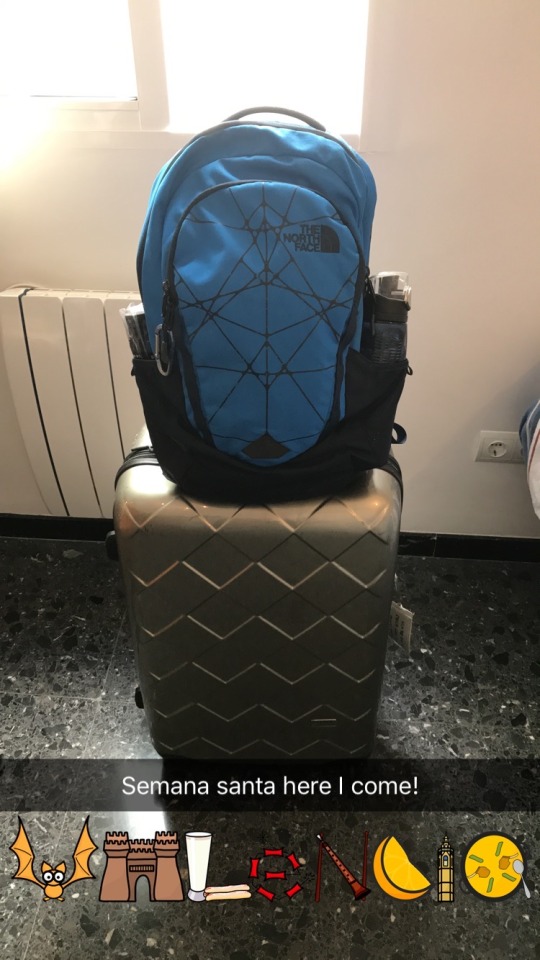
2 weeks, 7 cities, 1 Thomas. What could possibly go wrong?
1. GRANADA
A lot, actually. Well not really - just one thing. But a pretty major thing. Every millennial’s worst nightmare: I couldn’t charge my phone (gasp!)
Yeah, I know, you can groan and roll your eyes about how my generation is dependent on technology - I get it. However, when traveling alone in a foreign country, your phone is your lifeline. Not only does it serve as a camera (which is a convenience thing but not a necessity), it also serves as a map, translator, and emergency contact device (all of which are essentially necessities). Not to mention, I was traveling alone. So needless to say, having a functioning phone is important when traveling abroad!
After taking a train from Valencia to Granada and listening to music/texting most of the ride, my phone battery was pretty low. I wasn’t worried though, because I always keep a backup battery pack on me when I travel. I arrived at my AirBnB, got ready for bed, plugged my phone in to charge (or so I thought) and went to sleep.
The only problem was, my iPhone cord (for some inexplicable reason) chose that night of all nights to stop working. Being the dimwit I am, I just plugged my phone in overnight without bothering to see if it was actually charging. When I woke up the next morning and realized my phone was on 8%, I was an unhappy camper (to put it lightly). I needed my phone to navigate through the city and arrive at the Alhambra in time for my tour. If I was late, I would be denied entry, and I was not about to miss out on seeing it. The Alhambra is a famous Arabic palace, and is actually the most-viewed monument in Spain (see pic below).
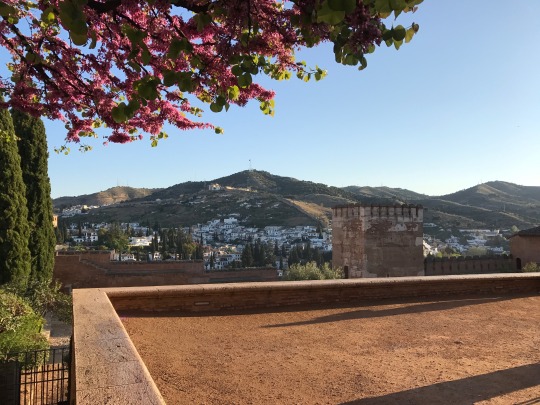
Friends who previously visited raved about how absolutely beautiful the Alhambra was and how I had to take a million pictures there. Well - that’s not so easy if your phone is your camera and it’s on death’s doorstep! I pulled out every trick in the book to make my phone last as long as possible: battery saver mode, airplane mode, even turned the brightness completely down. Luckily, I arrived in time for the tour, but using the GPS brought my battery down to around 2-3%. Miraculously though, my phone lasted on such low battery for almost the entirety of the visit! Normally, my phone would drop that much battery percentage in three minutes, let alone three hours! Even though with the backlight off I could hardly see what I was taking a photo of, I got pictures of the majority of the tour, and I think all things considered, they turned out pretty decent!

It’s a bit hard to make out in this shot, but on many of the walls of the Alhambra, the word Allah, the name for God in the Islamic faith, is spelled out to adorn the walls.





Interesting tidbit that our tour guide shared with us - although these windows look to be the same distance from the center of the wall, they're actually intentionally mis-aligned by 2 centimeters (that is, if you could fold this wall down the middle, the windows wouldn’t line up just right). This is because the creators of the Alhambra believed that there is no complete perfection except their God Allah, and any attempt to create perfection was blasphemy. The palace was constructed with many very tiny and virtually undetectable, intentional architectural and geometric errors due to this belief.
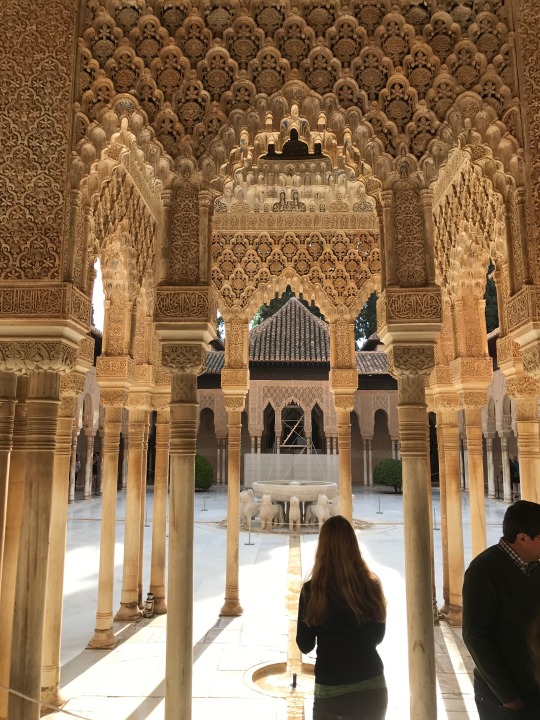
Palacio de los Leones, perhaps the most famous room in the Alhambra.

My luck got a bit better when the tour started - I had a reasonably small group. In fact, it was just me and one other family. And believe it or not, the other family was from Valencia! We got along really well, made some nice small talk, and the dad even emailed me some photos after the tour because I told him my phone had died.
The weird earpiece thing I’m wearing in the picture above is the latest in tour-guide technology - the guide speaks into a microphone softly and we can hear her explaining history and other details while we wander around and soak in the sights. While this is convenient, I suspect the main reason they do this is so that snoopy passerby don’t get to hear the tour without paying.
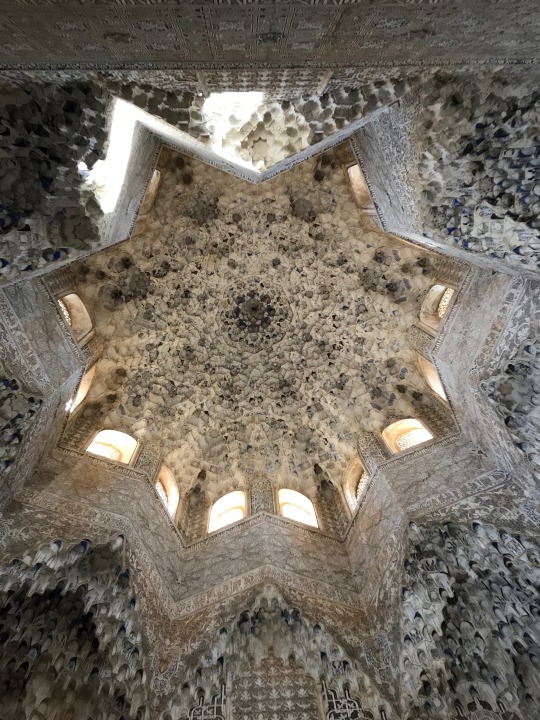
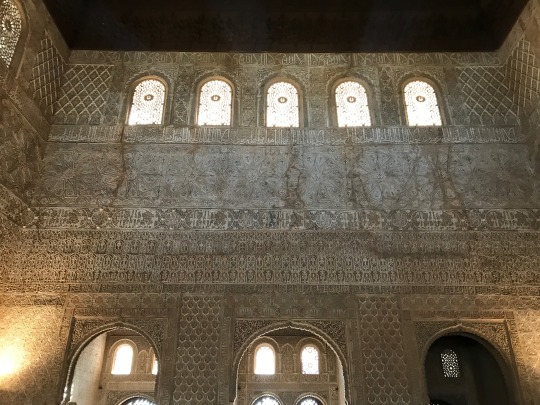
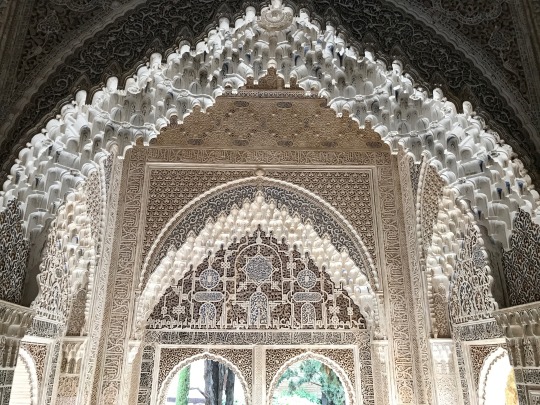

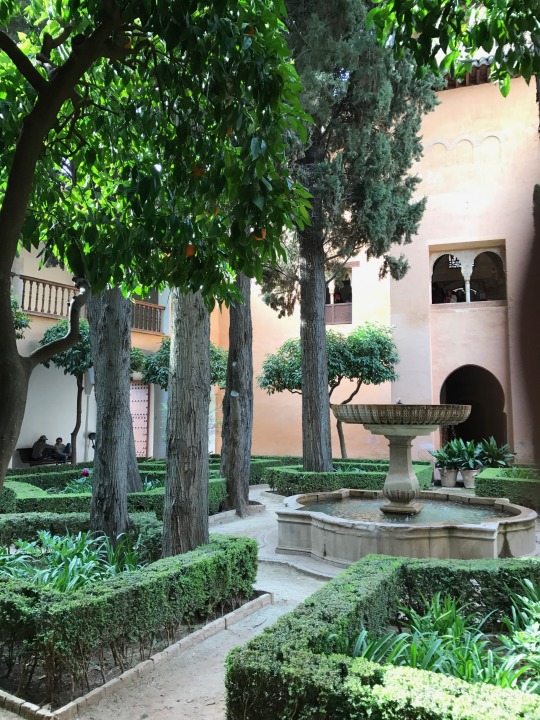



Some beautiful views of the Albayzín, a historic district in Granada.

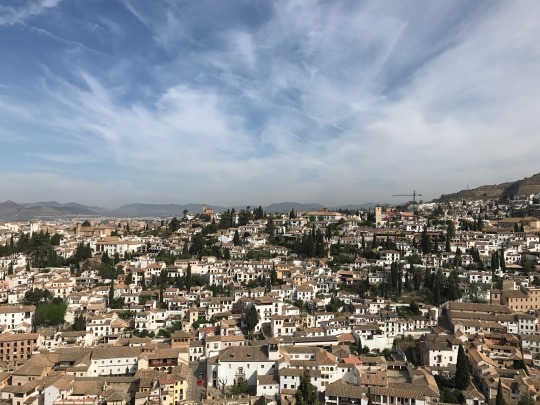



Jardines del Generalife

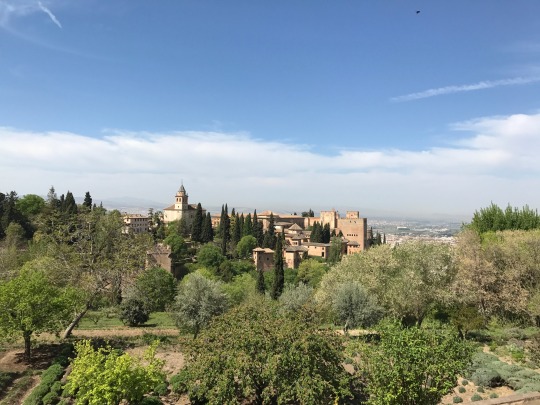
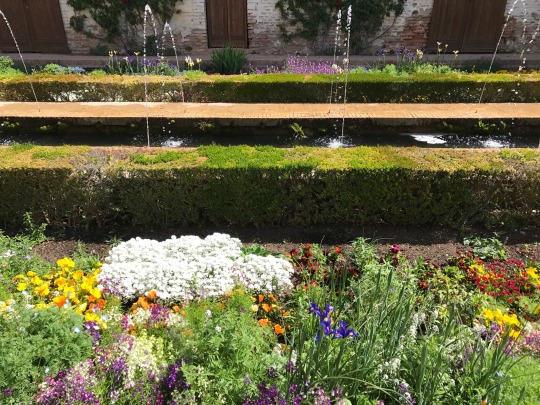

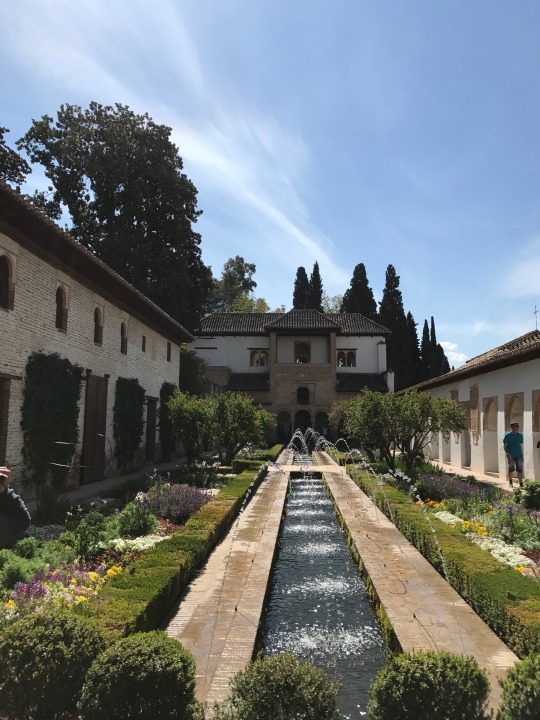

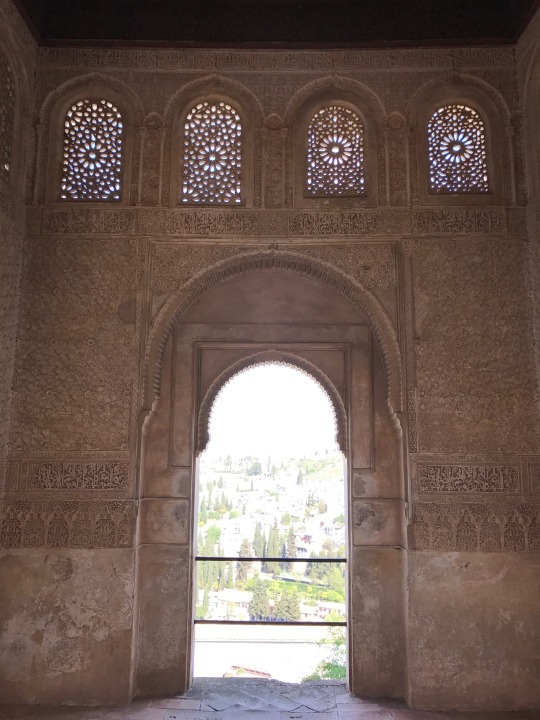

After this point in the tour, my phone finally gave out. However, I was all-in-all pretty impressed at how long it lasted with 2%, so I couldn’t complain. After the tour, the first order of business was to find a working iPhone cable (which was already difficult because most Spanish stores have weird hours, made even worse because it was a holiday) but eventually I found a charger at a sketchy mini mart and revived my iPhone. After that, I went to a bar to get a bite to eat. Although I didn’t think to snap a picture, I was reminded that I was truly in Andalucía when I ordered a drink and received free food that I didn’t even chose along with it. Although other areas of Spain have added tapas to their menus to try to reel in tourists, in their most authentic Andalusian form, tapas are free bites to eat that come with drink order, without you asking or choosing what you get. Cool huh?
After a quick siesta at my AirBnB, I paid a visit to the beautiful Cathedral of Granada

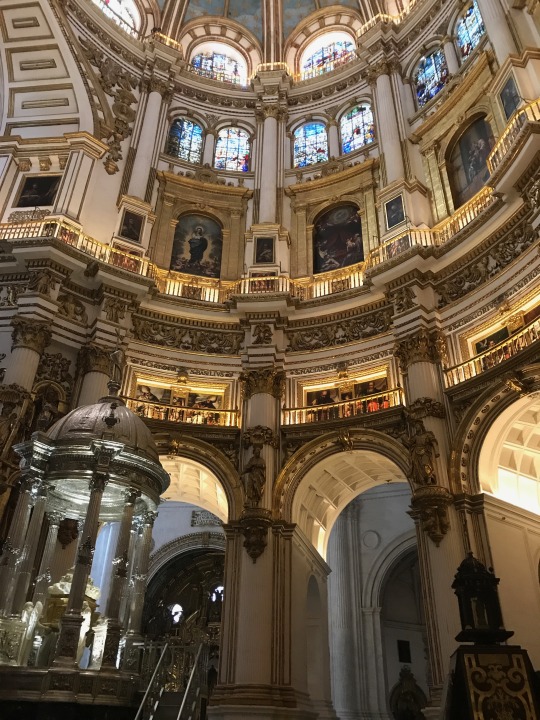
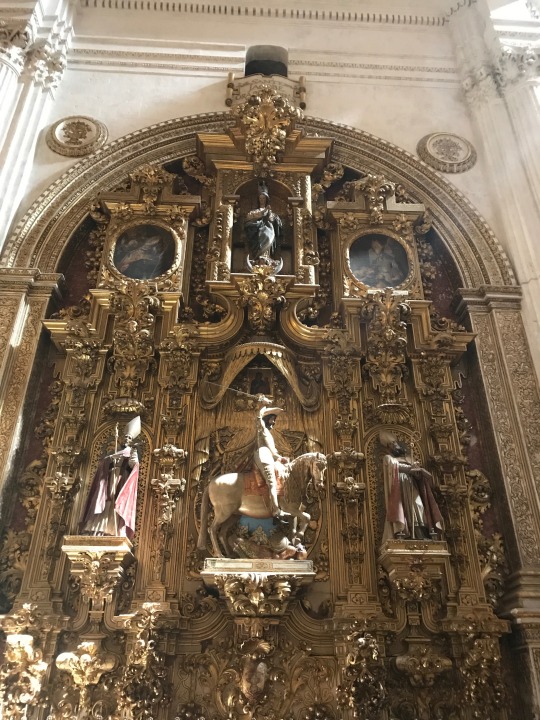



One of the many, many processions for Holy Week. Religious orders dress up and wear white robes and cone hats that I think look alarmingly similar to KKK outfits (but thankfully, there is no relation, and these processions far outdate the Klan anyways).
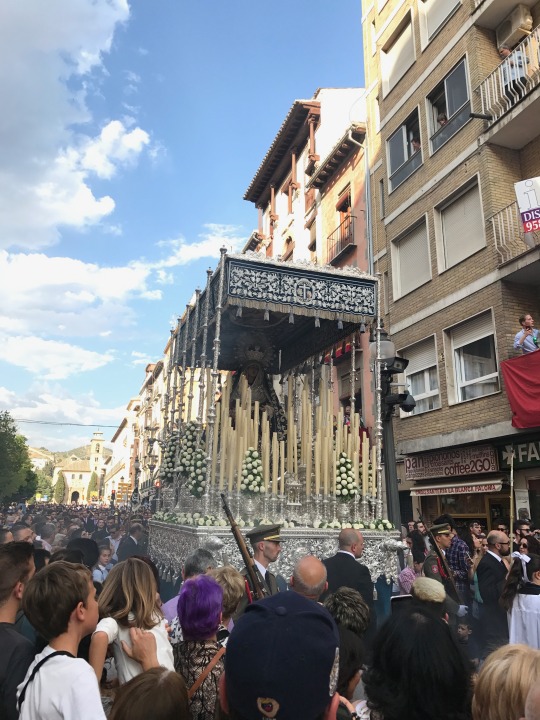
Many times in processions, members of religious orders carry an effigy of the Virgin Mary on a sort of pilgrimage. The candles you see are all real and lit, and the smoke is from incense.

Every so often, the procession stops at designated points and a vocalist sings a blessing in traditional Andalusian style over the Virgin.
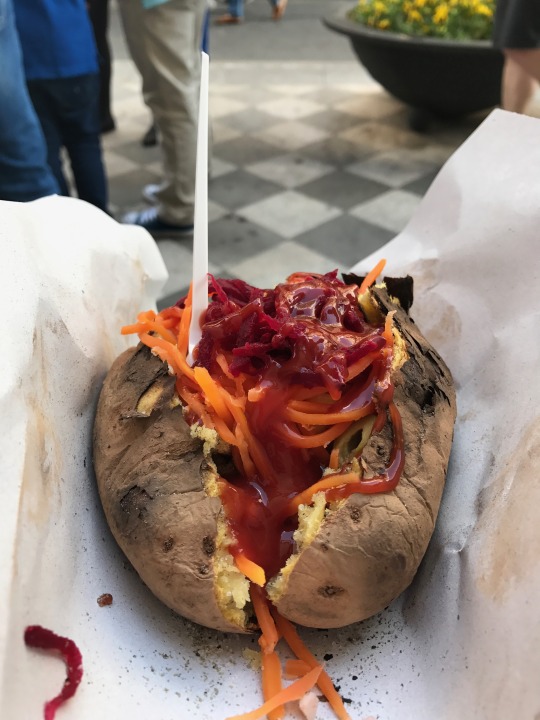
A huuuuge baked potato I got from a street vendor, stuffed with just about everything you could imagine: carrots, corn, cheese, pepper, and other ingredients I can’t recall now.
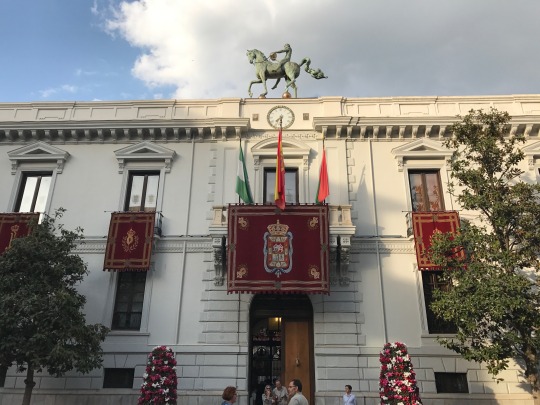
El Ayuntamiento (town hall) de Granada

Exploring the Albayzín (the little white village I saw from up above in the Alhambra earlier that morning).

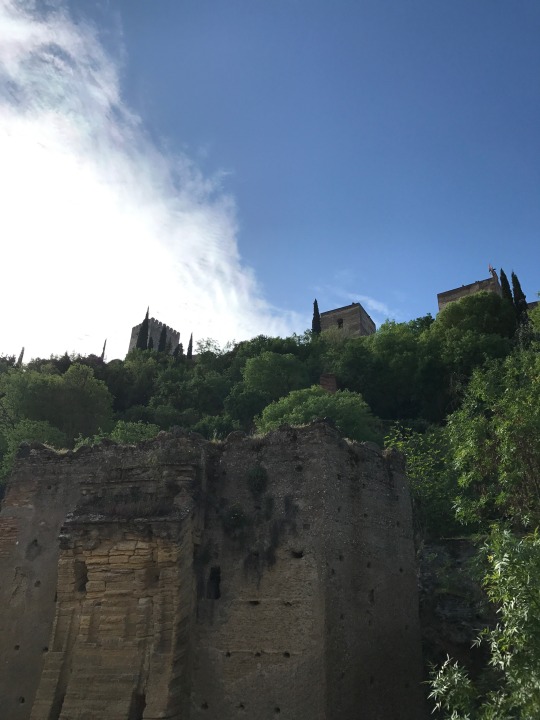

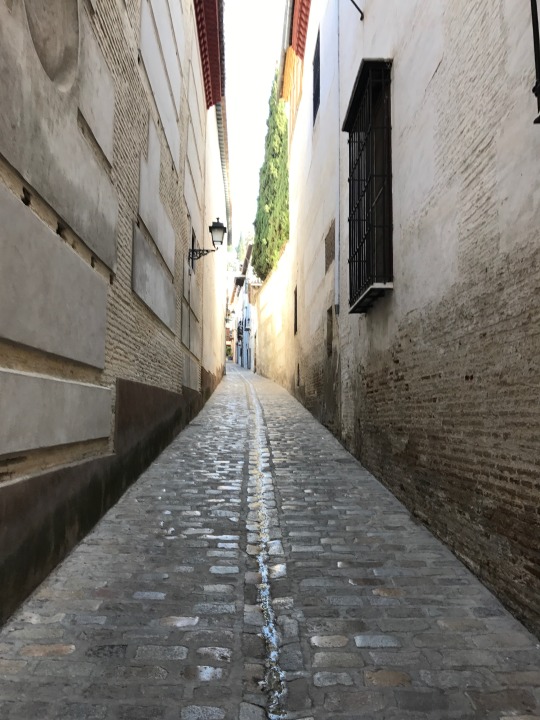

Mirador de San Nicolás, with a great view of the Alhambra.
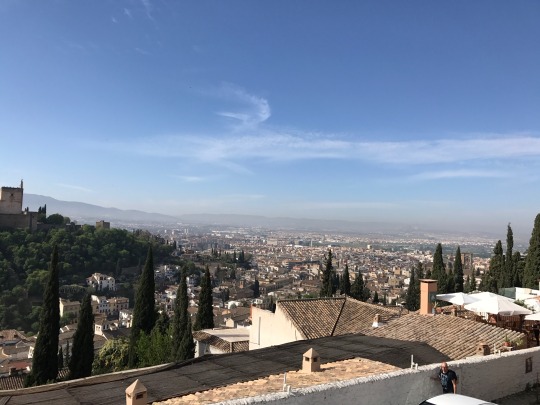



2. SEVILLA

When I arrived at my AirBnB in Sevilla, I was greeted by traditional Andalusian tiling on the stairs and wall. It can be a little much at times, but I still think it’s so pretty!
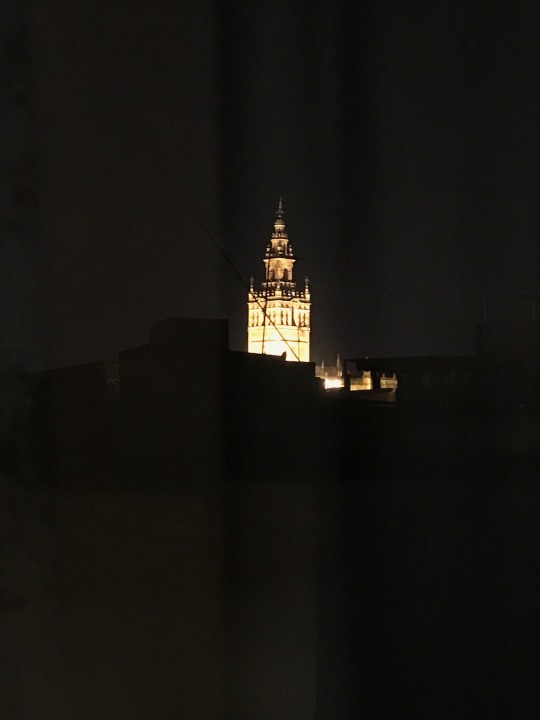
View from my AirBnB of la Giralda, the bell tower of the Seville Cathedral

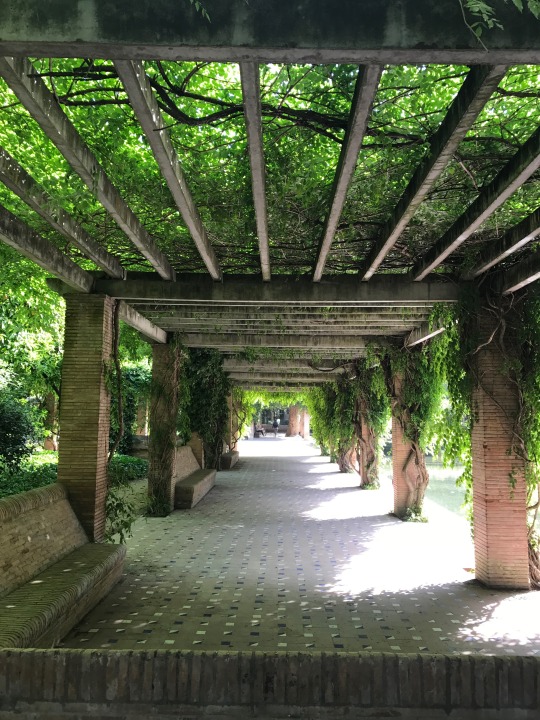
Parque de María Luisa


Plaza de España. My pictures simply do not do this place justice. I got here and absolutely fell in love - the plaza is simply beautiful. The ambience is distinctly Spanish and is filled with different sounds: street flamenco dancers and their shoes on mini-tablaos, the clip-clop of horse drawn carriages, the music of street performers, the chatter of castañuelas... I could have stayed there for hours.
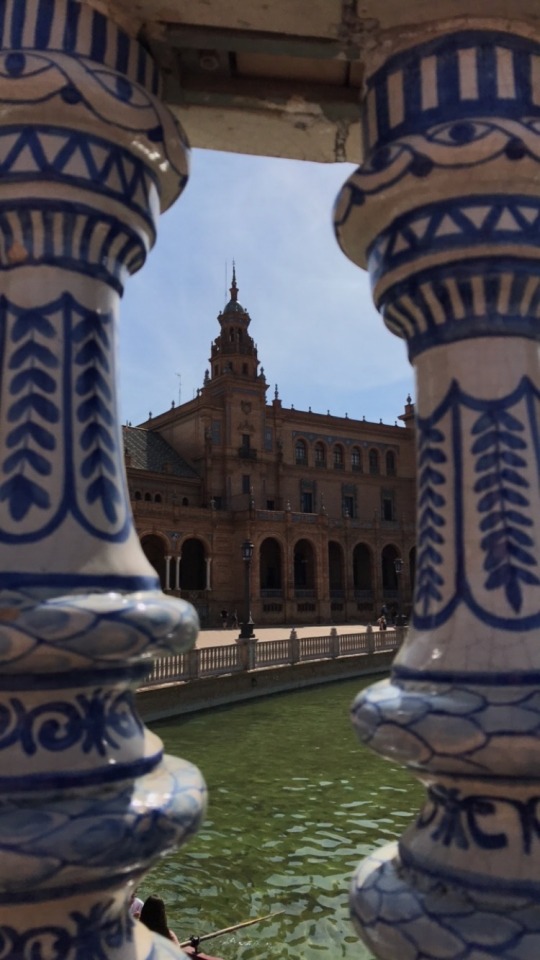
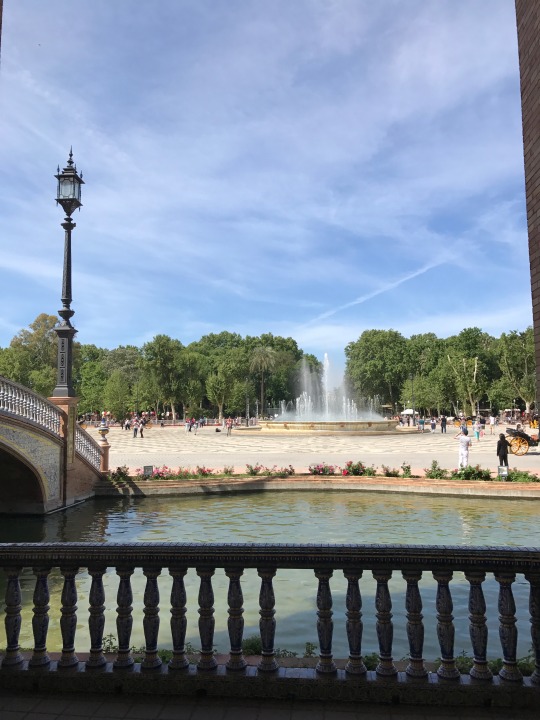

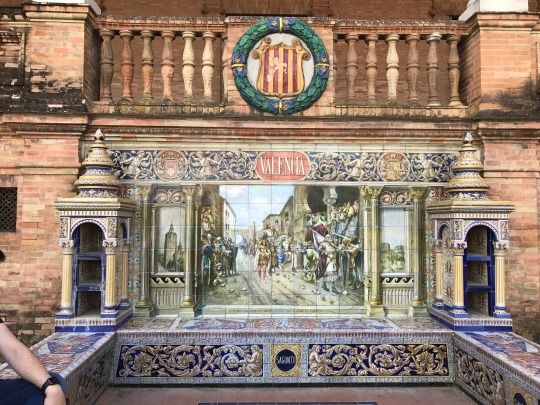
Every Spanish province has its own bench/monument in the plaza

I found some Valencians, and we took each other’s picture :)
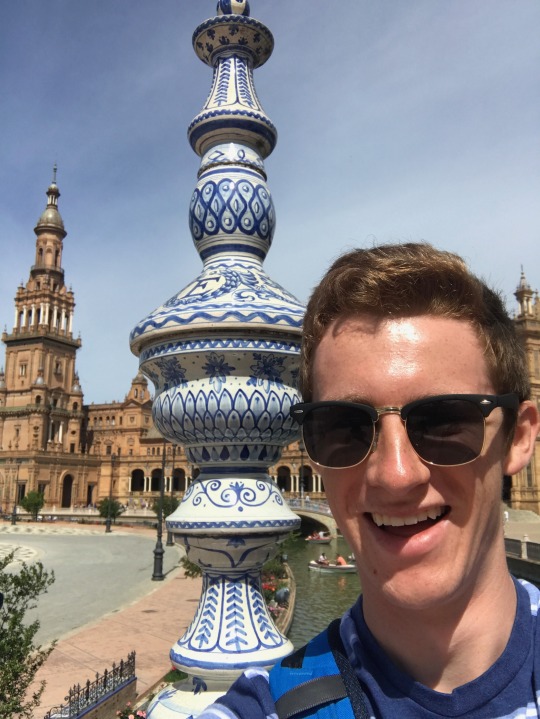
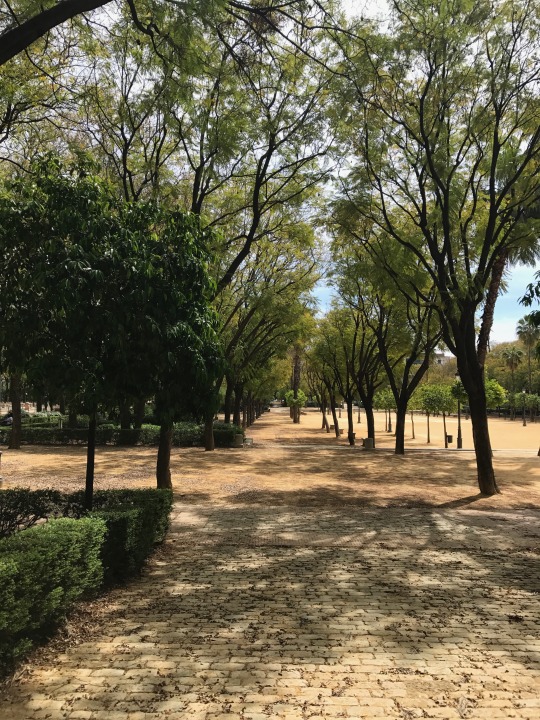

The view from the rooftop of my AirBnB

Another Semana Santa procession, this time in Sevilla. You should be able to make out the cone hats a bit more clearly in this one
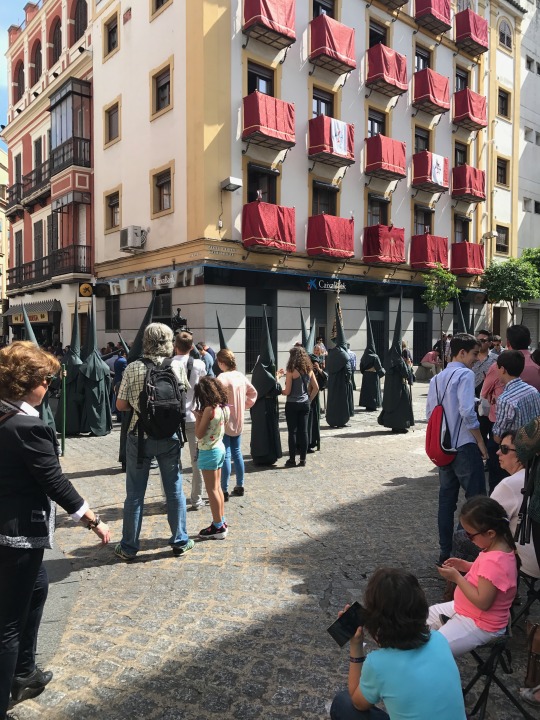
I learned that I had to be very flexible while navigating the streets of Sevilla. Not only were they a virtual labyrinth to begin with, many times I would finally find the right street to follow, only to be forced to turn around because it was blocked off by a procession. This trip was an exercise in patience and flexibility for me in many ways - in this case, instead of getting frustrated, I decided to just relax and enjoy the procession!


Another Virgin effigy
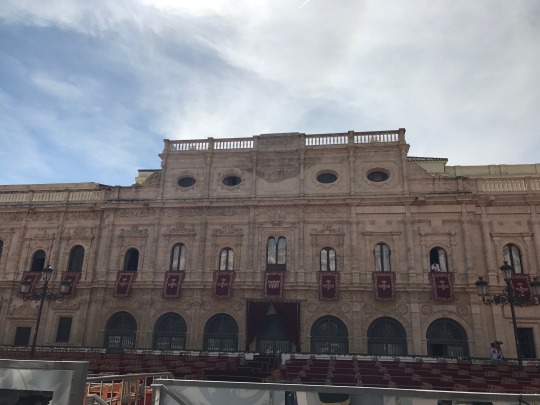


The Cathedral of Seville, the third largest cathedral in the world
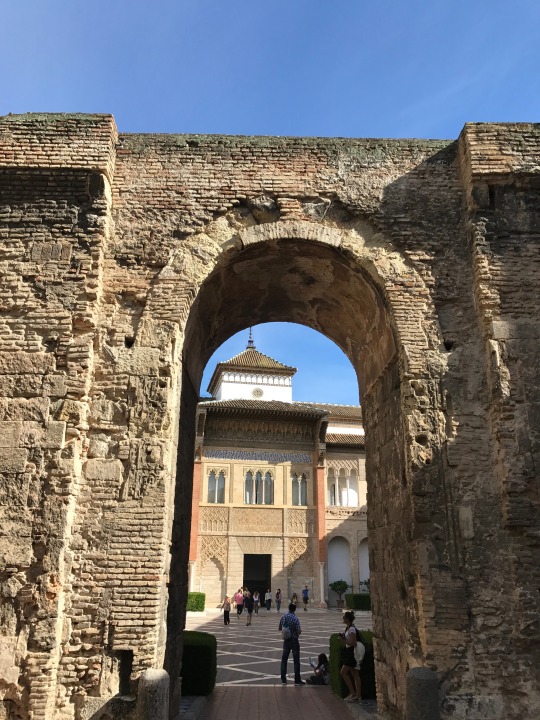
El Real Alcázar de Sevilla (the Royal Palace of Seville)
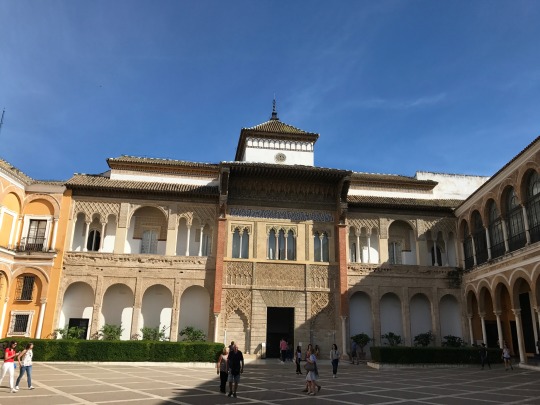
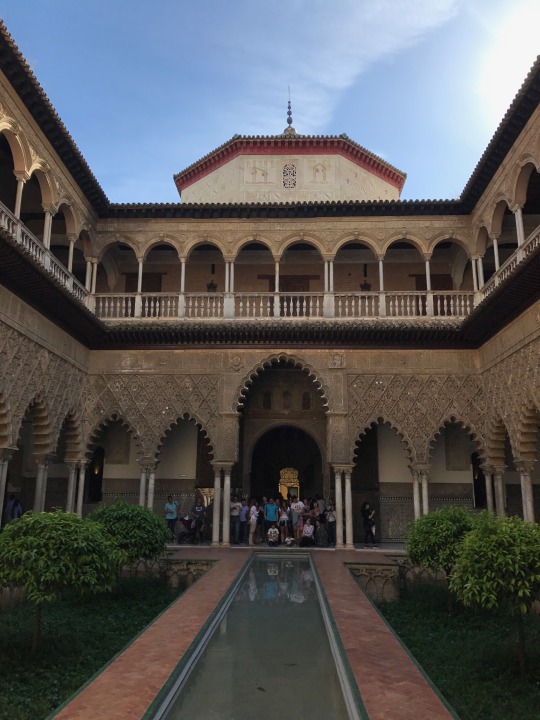
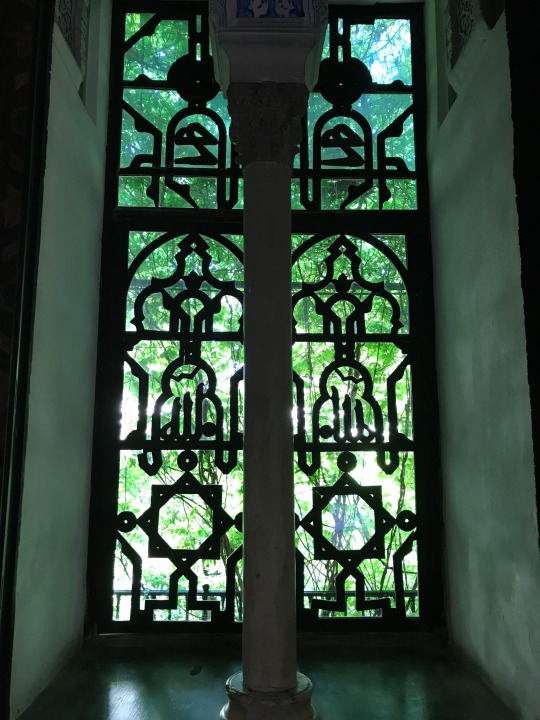


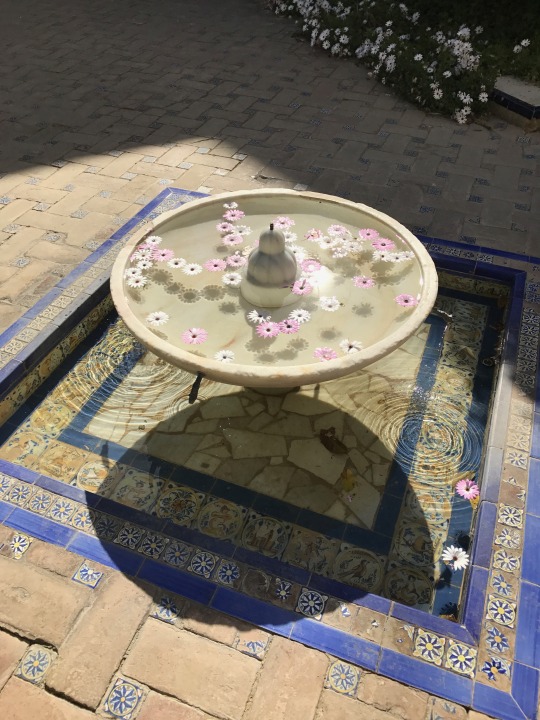
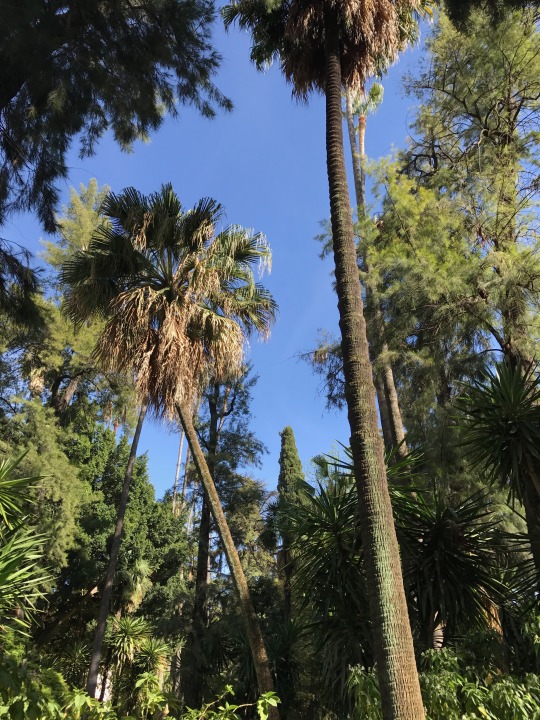



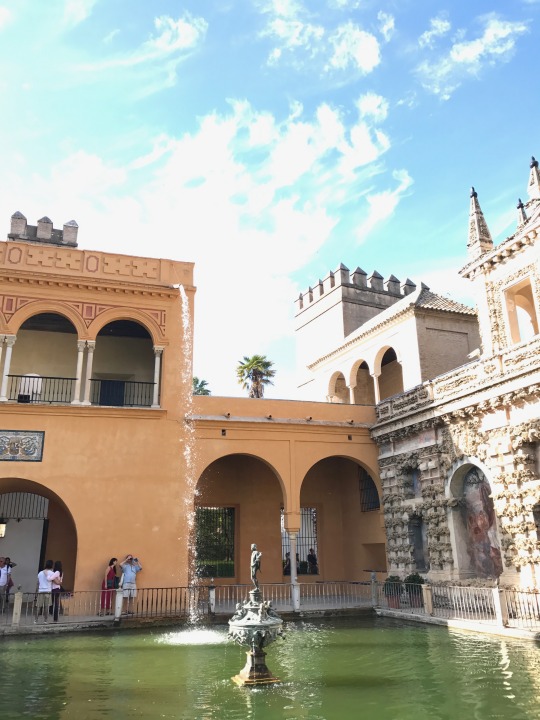
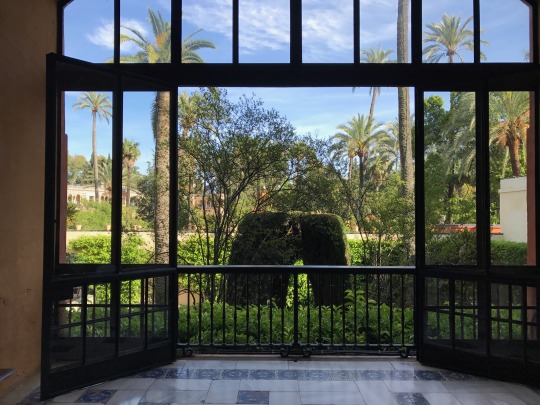



The palace gardens were gorgeous and very peaceful

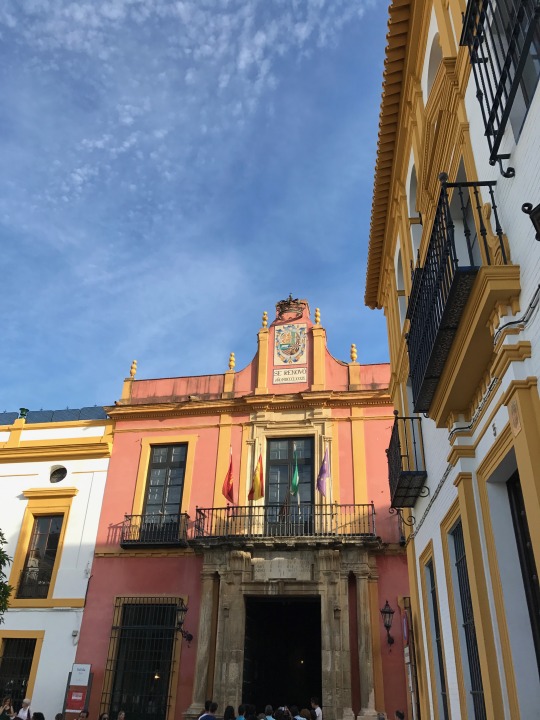
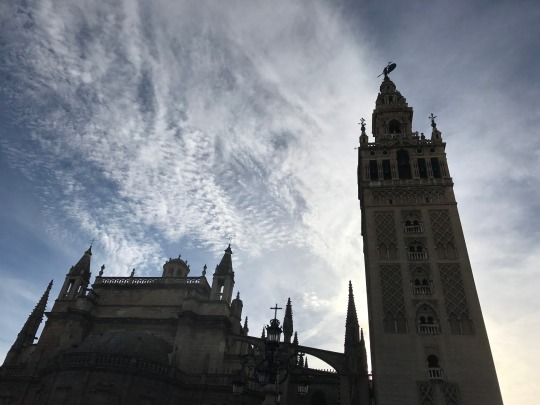

One of the processions either entering or leaving the cathedral (don’t quite remember which)
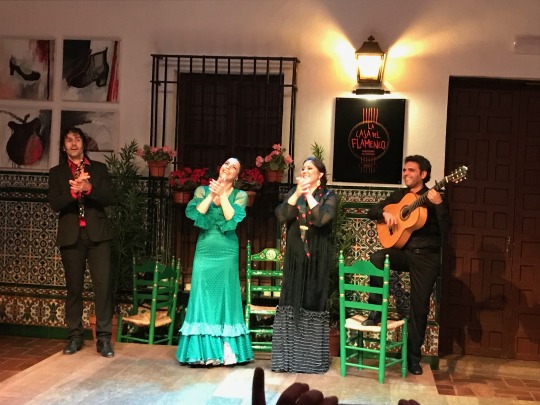
Flamenco Show. Unfortunately, there was no photography allowed until the very end. Although most spaniards would never really go out to see a flamenco show (it is almost solely a touristic attraction at this point), this show was performed in authentic style (or at least, that’s what the reviews on TripAdvisor told me!) and the dancers and musicians were very talented.

La Giralda at nighttime
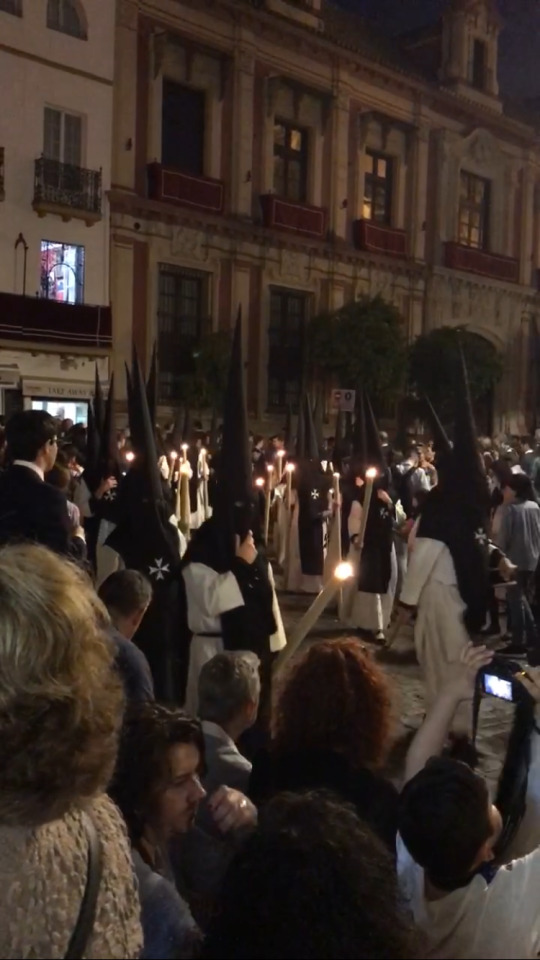
A procession the night before Easter.
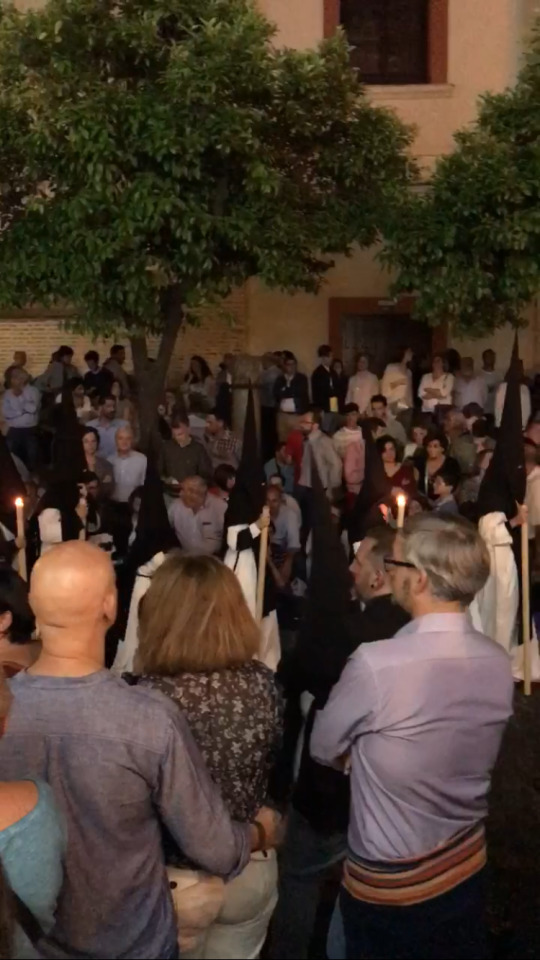
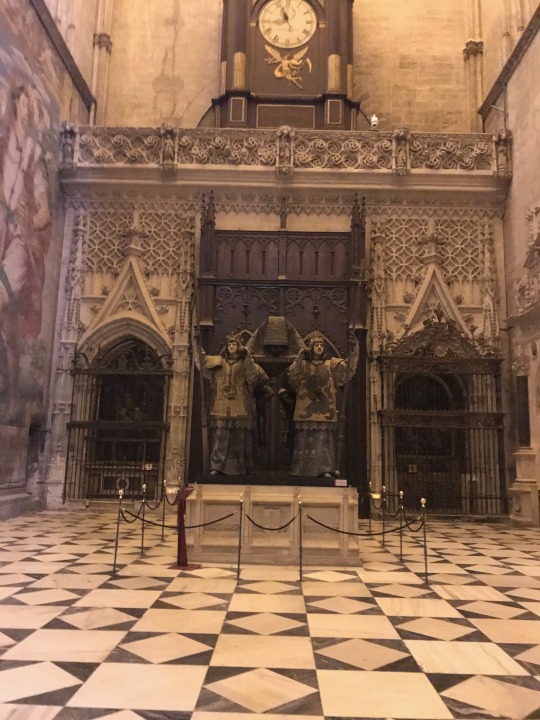
Pro tip - if you don’t want to have to pay to tour the cathedral, go to a service!


It’s pretty cool to say I went to Easter mass in the Catedral de Sevilla, the third-largest cathedral in the world!

A procession on Easter Sunday - notice the robes are white today instead of black, symbolizing purity but unfortunately looking even more like klansmen.
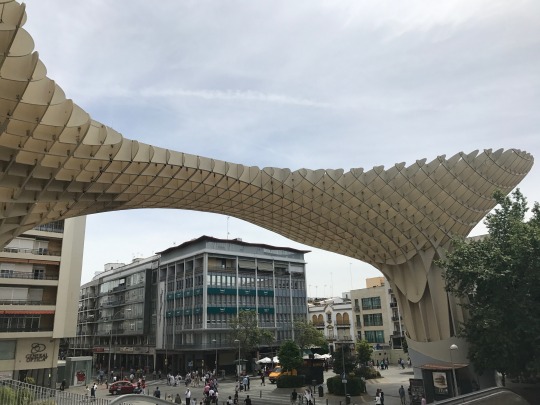
Metropol Parasol, an exposition center in Seville.


Ayuntamiento de Sevilla


La Maestranza, or la Plaza de Toros de Sevilla - The bullfighting ring of Seville

After having studied the culture behind bullfights year after year in Spanish classes, I finally got to see one for myself. Even though I had a feeling I wouldn’t like it, I decided I needed to witness a bullfight in order to form an educated opinion.

And... I hated it. I understand that bullfights are traditionally a way to honor the bull, but all I see is suffering and torture. The bull really has no options. If it is docile, it is prodded and goaded into attacking. If it is aggressive, it is tortured and then killed. What a way to spend Easter Sunday - paying to see the Lord’s creatures suffer unnecessarily :(



Although this bullfight had six bulls, I only got through three before I had to leave the stadium.


While I was waiting for my bus to Lisbon, they were filming a movie at the Seville bus station!
3. LISBON
The leg of my trip from Sevilla to Lisbon was by far the longest of my two-week journey, lasting around 8 hours total. I was horrified upon boarding my bus to observe that there was no bathroom located in the back, knowing full well that nothing short of a miracle would allow me to survive 8 hours without being able to use facilities. I did notice a few elderly couples on the bus as well, and figured they would crack before I did. I assumed that if the bus had no restroom, it would have to make rest stops at least every other hour, but 3 hours into the ride it had not stopped once. It wasn’t until a girl got up from her seat and disappeared behind me that I realized the bathroom on board was ingeniously built (disguised) into the side of the rear-exit stairs. Although this location forces you to more or less climb into the lavatory, I was quite relived to realize that there was indeed a bathroom on board. Who would have thought?!
On a more serious note, traveling to Lisbon by bus really helped me realize just how cool the European Union is. Because both Spain and Portugal are part of the Schengen Area, the free-movement zone of the EU, they have no border control. Driving into Portugal was as simple as driving from one state to another in the US. There’s just a “Bem vindo a Portugal” sign and that’s it - you’re in a new country! In fact, I totally forgot I had left Spain, and when the bus driver took a break at a rest stop (this rest stop finally came after I had discovered the on-board bathroom), I accidentally tried to order food in Spanish!
However, speaking Spanish is still of some value in Portugal. I found that if the person I was speaking to didn’t know English, I could still have a jumbled conversation with them if I asked a question in Spanish - I would just recieve a response in Portuguese. Although the two are absolutely separate languages, they share their similarities, and I was surprised at how much Portuguese I could vaguely understand given my knowledge of Spanish. Written Portuguese was even better. I found that when I concentrated too hard on deciphering Portuguese, I psyched myself out, but when I just did a calm skim over the text, I could get the general idea. This was very useful in a wide variety of scenarios, from understanding instructions from my AirBnB host to reading public transit maps.

Praça de Dom Pedro IV (Rocio)
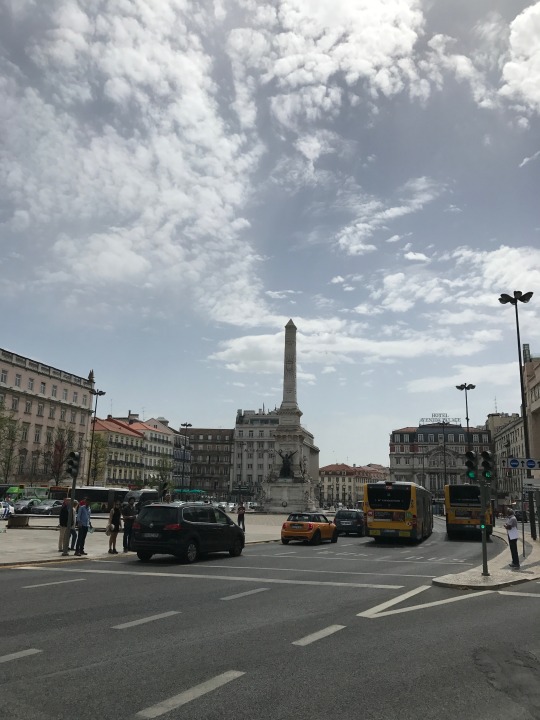



From my observations, Lisbon seemed to rely much more on tram cars than on busses for public transportation.

Some of them were older while a few were more modern
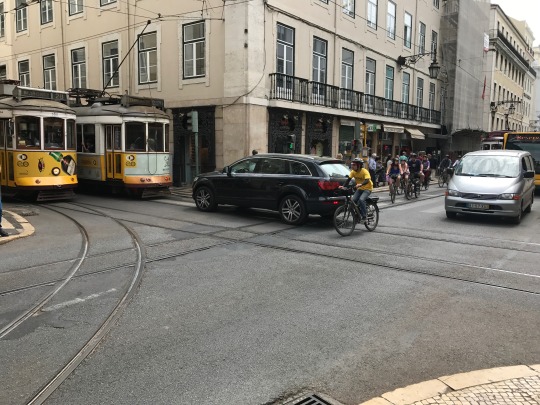
I just had to stop here and get some shots of the laughably difficult-to-navigate roads in center city Lisbon. Between cars, trams, busses, cyclists, and pedestrians, the roads are a mess.

Take this scene for example. A car is trying to go down a street that is completely blocked by two tram cars. This makes a further traffic jam because the car isn’t able to finish its turn, irritating cyclists, all while a pedestrian jaywalks in between the car and trams. Crazy huh?

Cais das Colunas.

Arco da Rua Augusta
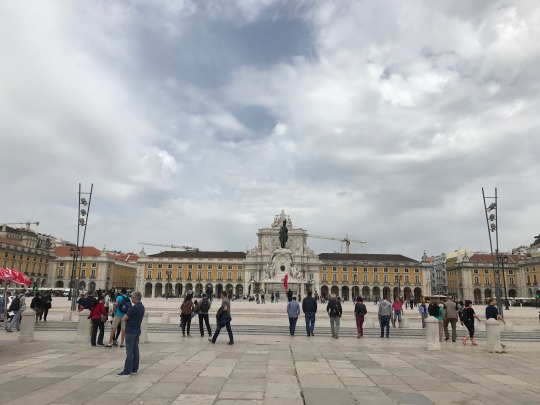
Praça do Comércio
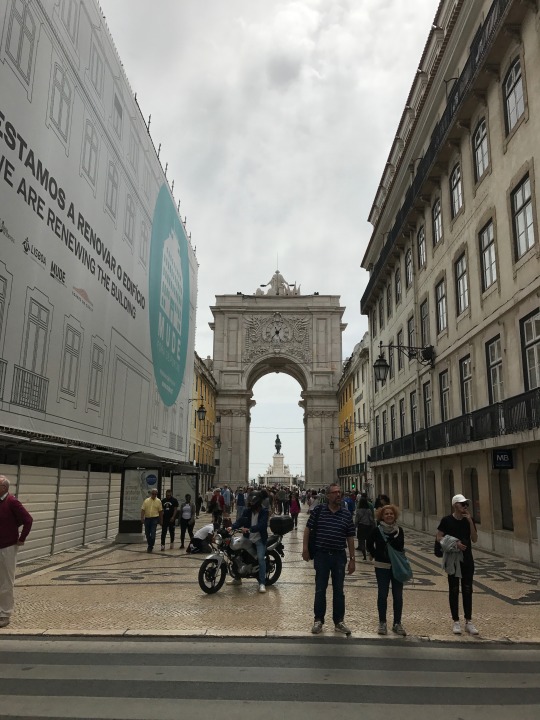
Next, I went on the Elevador da Glória - similar to the trams I mentioned earlier, except it scales a mini-mountain. The picture right below is what the elevador is supposed to look like...

but the next picture is what it actually looks like.
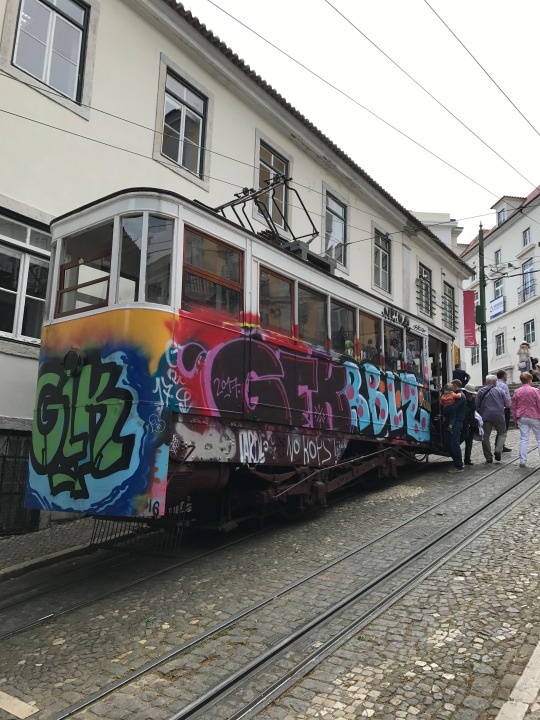
Thank you street artists!
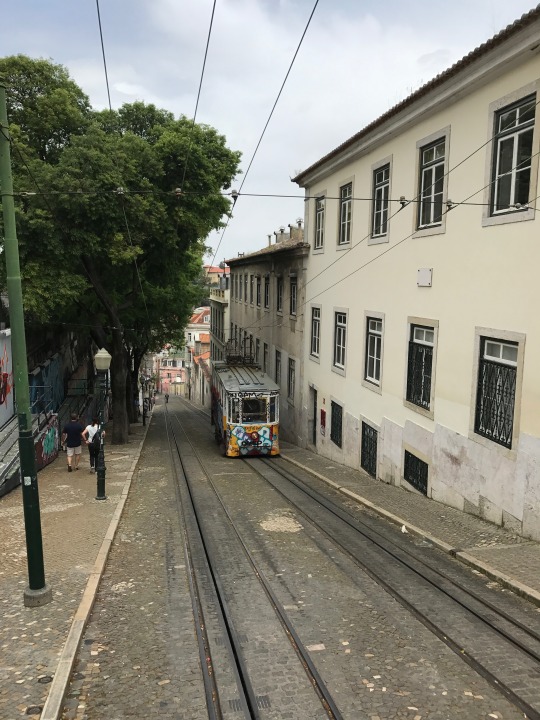

The ride was cool and all, but it was majorly overpriced and there wasn’t really anything at the top, so I was a little disappointed.
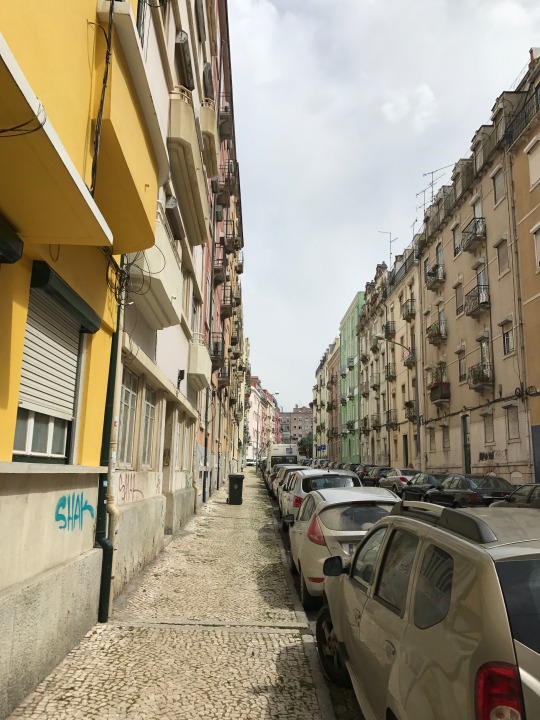
The street that my AirBnB was on - pretty jam packed with cars, but still pretty. I love all the different brightly colored buildings.

The craziness that is the Rua Augusta
Later that afternoon, I went to Belém (Bethlehem in English), a municipality of Lisbon that was by far my favorite part of my visit to Portugal. I didn’t take any pictures of it, but in order to visit the various monuments I walked through a beautiful park full of happy couples, children running around playing sports, and picnics in the grass. Oddly enough, passing by and enjoying the calm scene hit me with a wave of nostalgia for home - who would have thought a park in Portugal would make me yearn for an American summer?

Mosteiro dos Jerónimos, a beautiful monastery that I admired from the outside because I’m too cheap to pay the entrance fee for everything (and trust me, I had paid enough to enter various religious buildings by that point).
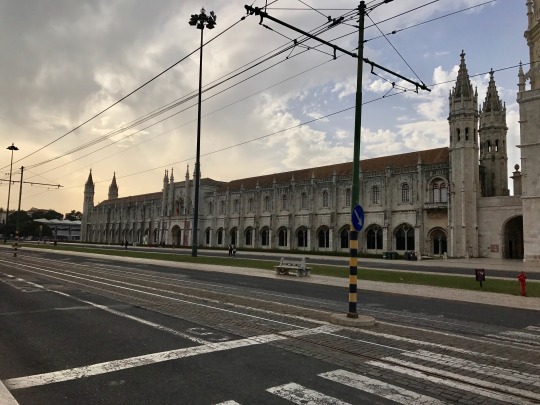

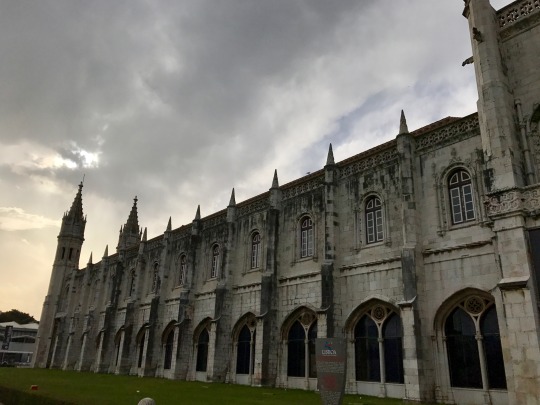

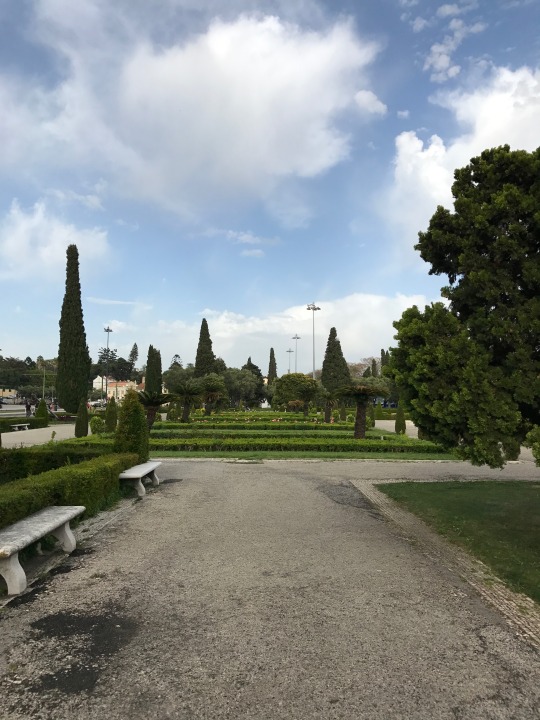

Padrão dos Descobrimentos
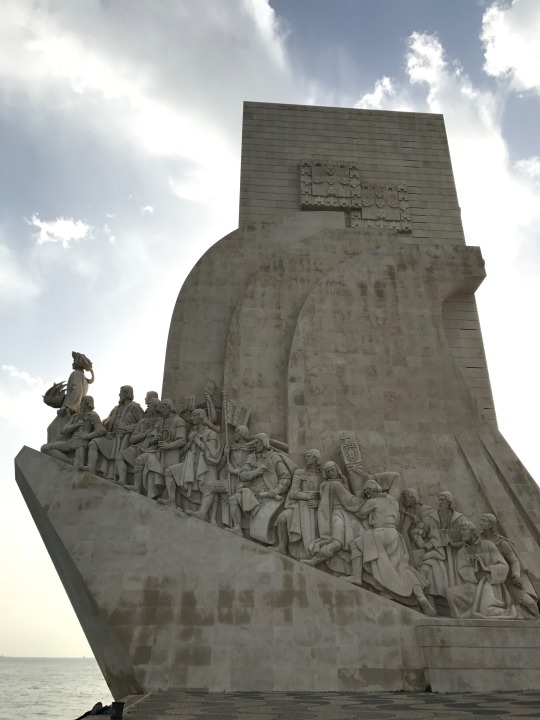


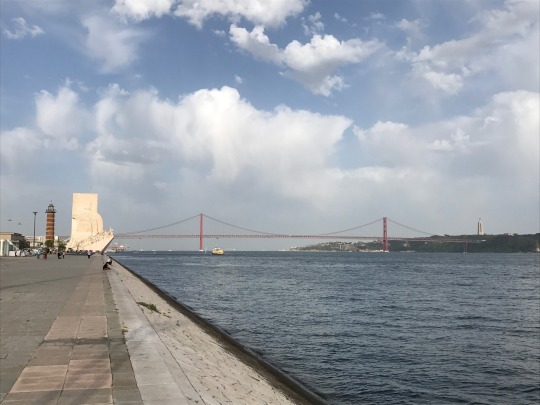
Lisbon trying to get that SanFran aesthetic?

Torre de Belém, beautiful at sunset

The next day, I took a short-distance train to Sintra, a famous national park on the outskirts of Lisbon.


Palácio Nacional de Sintra


To walk to the Moorish Castle, I had to hike through some of the forests of Sintra. The pictures truly don’t do the walk justice. On family vacations, I’m normally the one who complains about hiking, but this hike had even me blown away by its natural beauty and great look-out points.
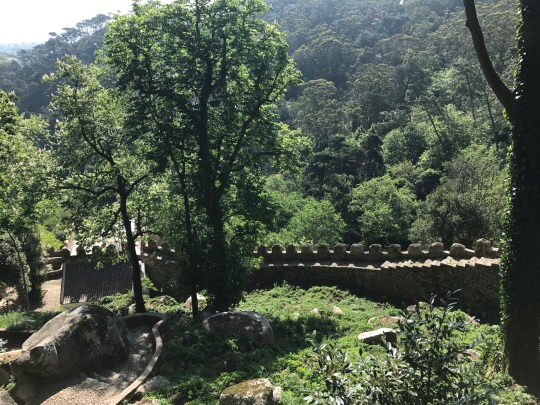



If you look closely, you can see the Moorish Castle (Castelo dos Mouros) on the mountain in the distance. However, I couldn’t hike all the way up to see it, because there was a steep entrance fee and I’m a cheapskate.

The Palácio da Pena. Get ready for a ton of pictures of this one... I just couldn’t help myself. To me, the architecture is absolutely stunning and very original. For this one, I did cave and pay to go inside.
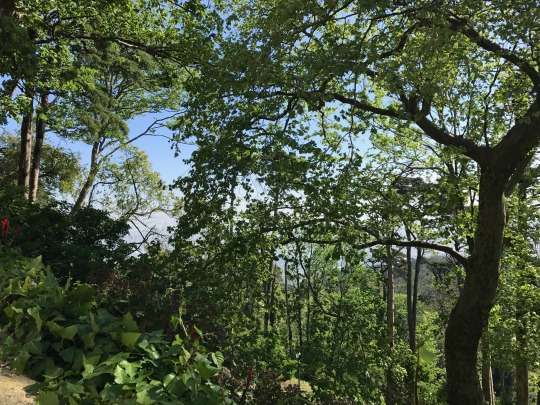

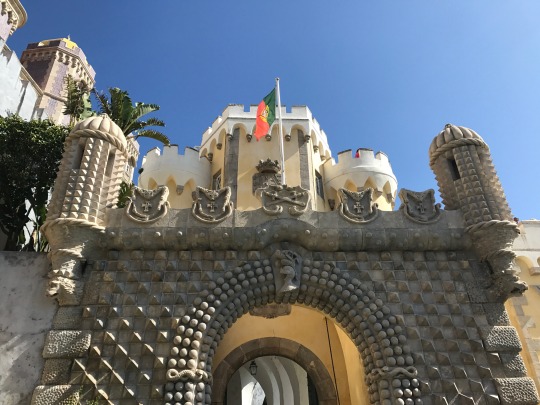
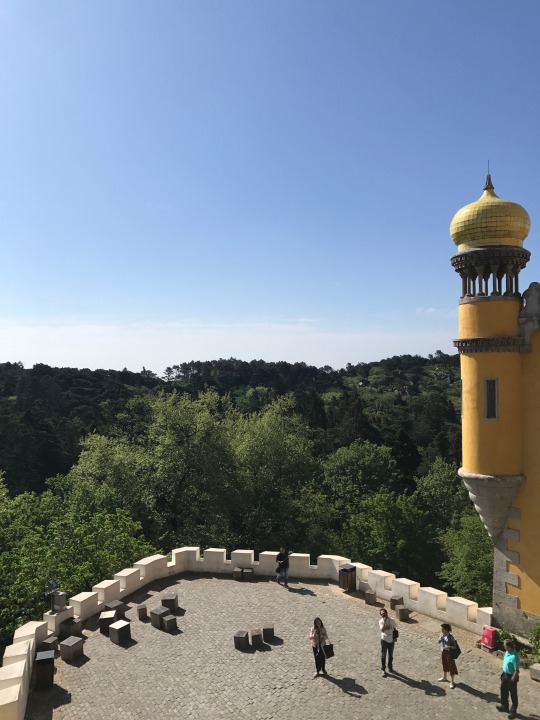

Like... is that incredible or what?!

Look closely to see the village houses out in the distance
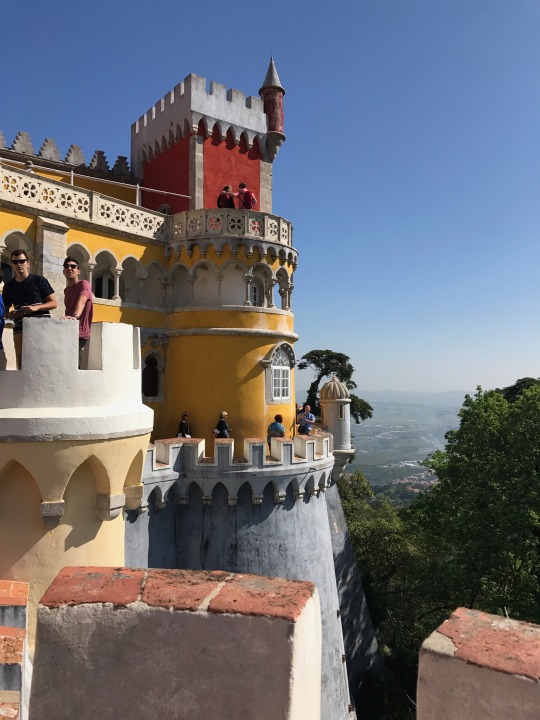



If you look closely, you can see the Moorish Castle on top of the mountain.

What is a trip through Europe without unflattering selfies??

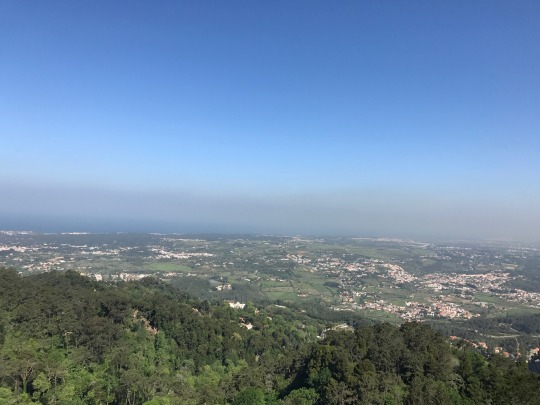
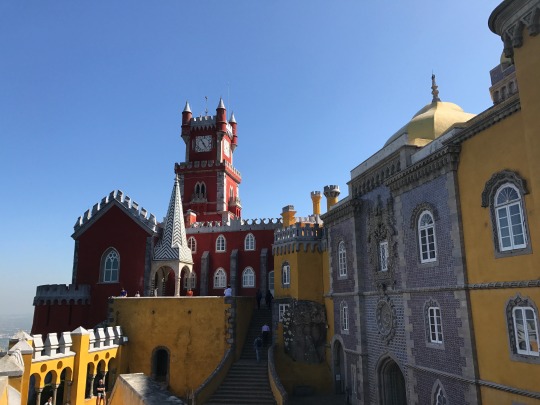
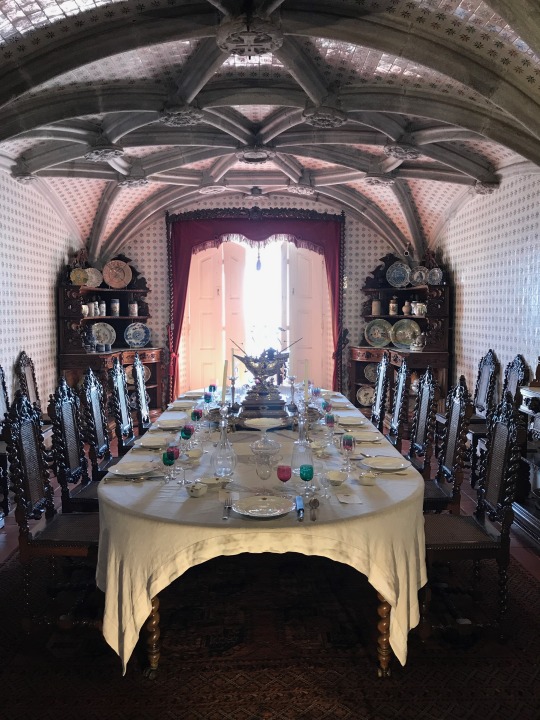
(See look I told you, I actually paid to go inside this once!)
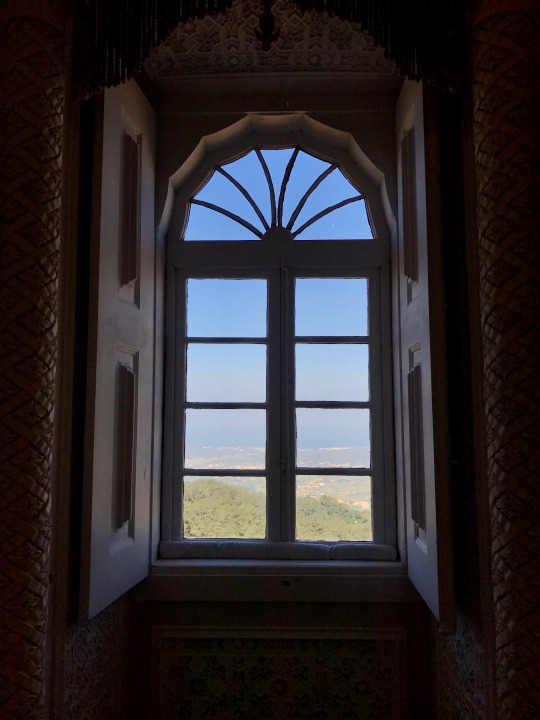




After visiting Sintra, I took the train back to center city Lisbon to explore until I had to leave for my flight to Bilbao
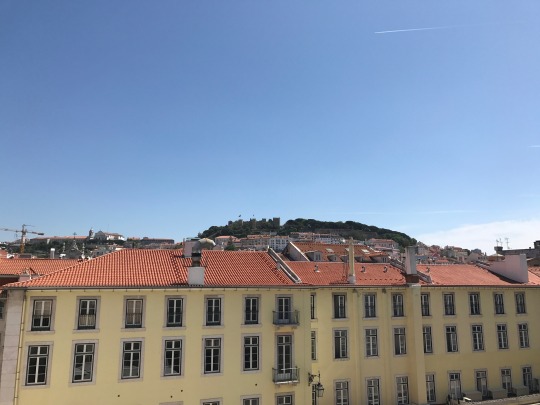
Back in center Lisbon near the Praça de Dom Pedro IV. On top of the hill you can faintly make out the Castelo de São Jorge, where I took these next few pictures
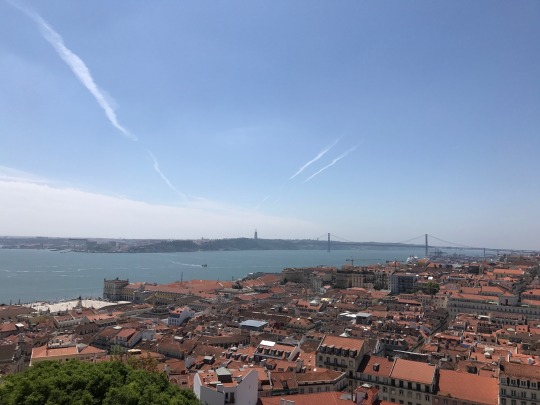
The view at the top was magnificent - shame there was no Elevador da Glória to make this (significantly more challenging) ascent






The walk down was great!

The walk back up, not so much...
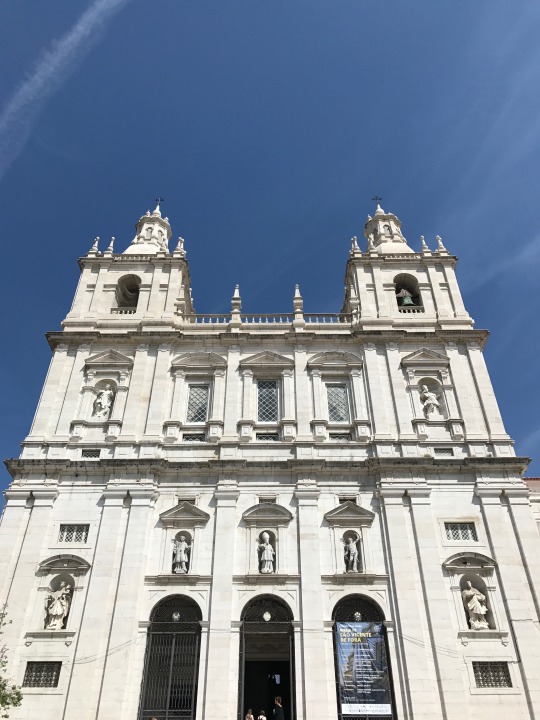
Igreja de São Vicente de Fora

For my flight to Bilbao, I was very frustrated that the online check-in did not work for me for some reason. I figured this was because I had purchased the flight off a semi-sketchy third-party website with a great deal on tickets. Knowing this, I got to the airport extra early to get in line and check in the old-fashioned way, intentionally leaving plenty of wiggle room even for an international flight just in case there were any problems with my ticket. Little did I know I would have the most incredible luck when I got to the airport.
First, as I was stopping to get something out of my backpack, a sweet random woman came up to me and asked if I would like some chocolates. Her suitcase was overweight and she was trying to get rid of things. Not too bad huh?
The nice happiness-boost from the chocolate lady wore off pretty quickly when I saw the check in line. It was colossal (the airport was busier than normal because of the Easter season) and moving slowly. I tried to check in on my phone and on the digital machines one last time, but still no luck - each time I would just get a message saying I had to go talk with customer service, so I grudgingly joined the humongous line.
I had barely been in line for 5 minutes, however, when a very kind airline employee came up and asked me what I was waiting in line for. Evidently, because there were so many people waiting to talk to customer service and he just happened to not be busy, he was working from the back of the line up to see if he could help customers and reduce the line. I explained that I just needed to check in for my flight, and he asked me to follow him. He accompanied me to another station where he allowed me to completely cut the line, after which he promptly checked me in and printed my boarding passes. He told me that I had actually purchased budget tickets that didn’t include a checked bag (thanks sketchy third-party website), and that I would normally have to go back to customer service to pay to check my suitcase. However, because the customer service line was already way out of hand, he said he would just go against company policy and check my bag for free. I was completely flabbergasted and could not believe my luck. I thanked him profusely as he hurried away to assist another customer. I honestly felt undeserving of such a stroke of good fortune - I had arrived at the airport with time to spare, and surely there was someone in more of a rush who could have used that godsend more than I could have. Either way, I just had to give that mysterious TAP Airlines employee a shoutout - you the real MVP man.
4. BILBAO
I really enjoyed my time in Bilbao. I happened to visit during the week they were doing a sort of “piano project,” where a number of pianos were placed in public spots and anyone could just walk up and play them. I was lucky enough to come across at least four while exploring the city!
Another neat thing about Bilbao (and Basque Country) in general is their language, Basque or Euskera. Words in Basque can be pretty intimidating to pronounce, to say the least. I didn’t think to snap any pictures at the time, but the picture below I found on Google of a street sign gives you a bit of an idea. Thankfully, everyone (or mostly everyone) also speaks Spanish, so I didn’t really run into any trouble.


I think the snapchat caption just about says it all. My AirBnB hosts had to get up early the next morning for work and I had already arrived a bit later than anticipated, and I didn’t want to irritate them even further by waking them up at such an ungodly hour - so I just sucked it up and waited until morning.

Churros and cola-cao, a delicious breakfast (even if it is pretty meager)

Parque de Doña Casilda Iturrizar

El Cachorro (the puppy), a sculpture made of flowers that’s supposed to look like a west highland white terrier. Unfortunately, the flowers were not quite in bloom yet.

The Guggenheim Museum
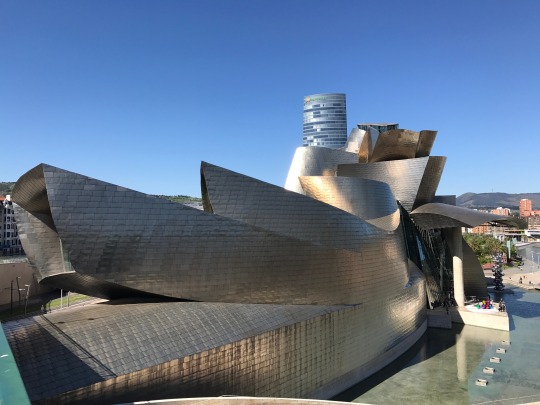
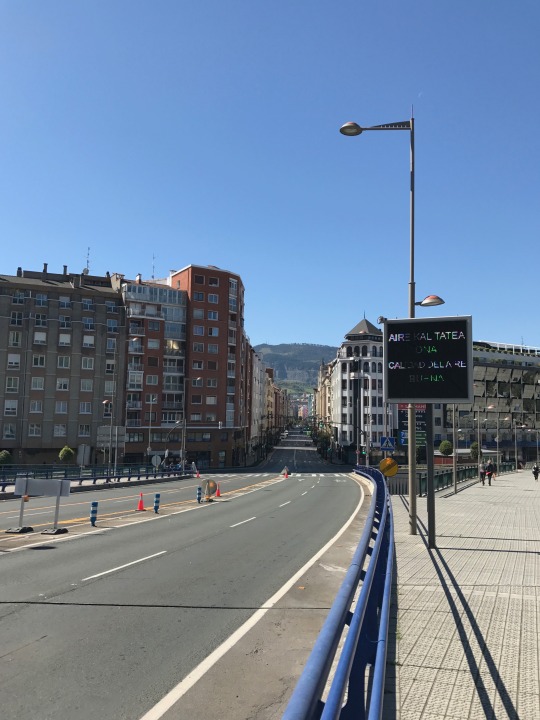

Ayuntamiento de Bilbao
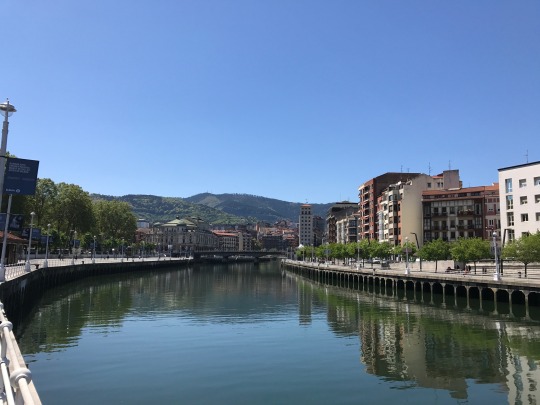
Río Nervión

El Casco Viejo
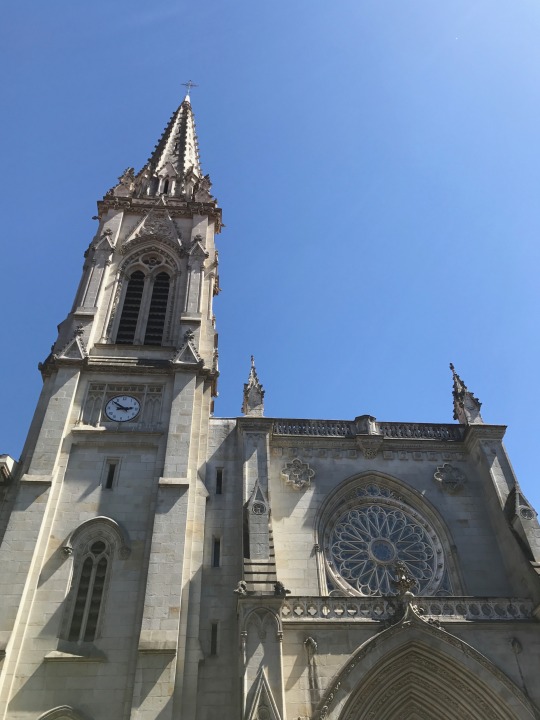
Catedral de Santiago de Bilbao

Iglesia de San Nicolás

La Alhóndiga. This is a cool one - it’s a multipurpose building in center city Bilbao to serve various needs for city residents. Among other things, it has restaurants, shops, a library, a gym, a movie theater, and an auditorium.
5. SAN SEBASTIÁN
San Sebastián is a very popular beach town to the east of Bilbao. It’s actually quite close to the border with France, and I heard just about as much French spoken while visiting as I did Spanish. Although the water was too cold to swim in and the wind made even laying on the beach a bit chilly for my taste, the city was absolutely beautiful.
To get from Bilbao to San Sebastián was only about an hour ride by bus. When I purchased bus tickets online, I wasn’t really paying too much attention to the type of bus, and €15 seemed a reasonable price to me so I didn’t think anything was out of the usual. However, I was blown away when I saw a sleek black bus that said “ALSA Premium” on it pull up to the station and realized it was for me. This bus was by far the fanciest I’ve ever been on. I mean, it had a flight attendant. On a bus. What? Did I mention complimentary snacks and beverage service? I sure wish I had this bus for my 8 hour ride from Seville to Lisbon! I was almost sad when the ride ended. I found a picture of the bus model online so you can get a better idea.


The Río Urumea, that flows through the city of San Sebastián and into the Bay of Biscay.
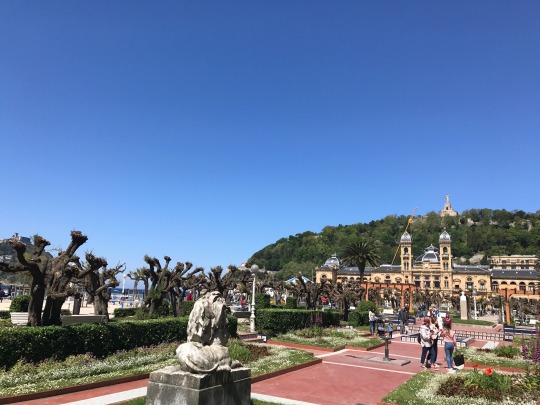
El Ayuntamiento de San Sebastián


Playa la Concha




Such amazing artistry - a man down on the beach was drawing all these designs in the sand, and passerby on the bridge where this photo was taken would throw money down for him.
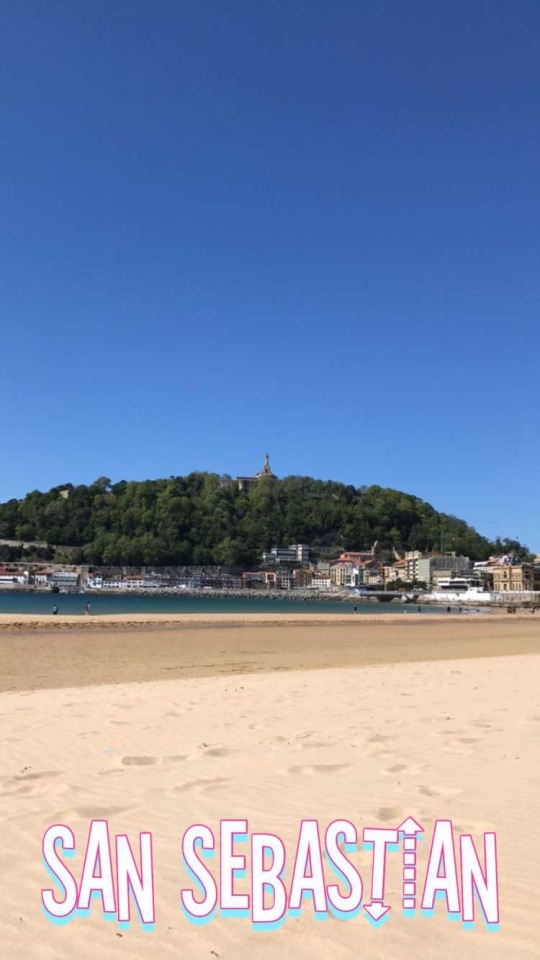


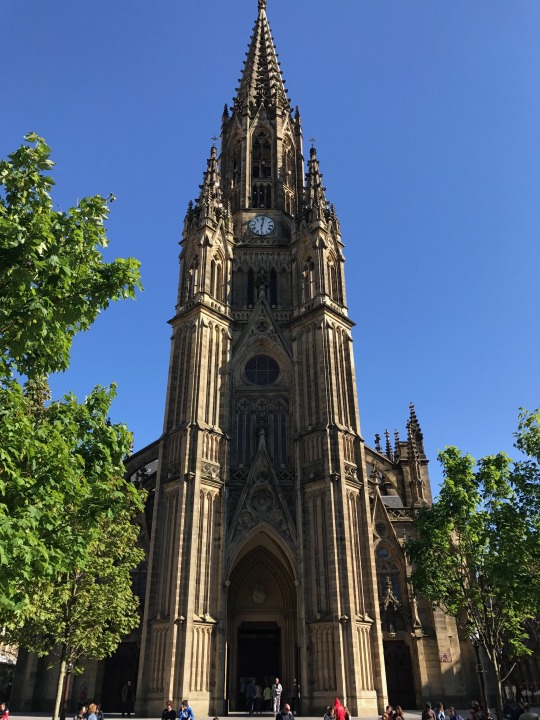
Catedral del Buen Pastor de San Sebastián
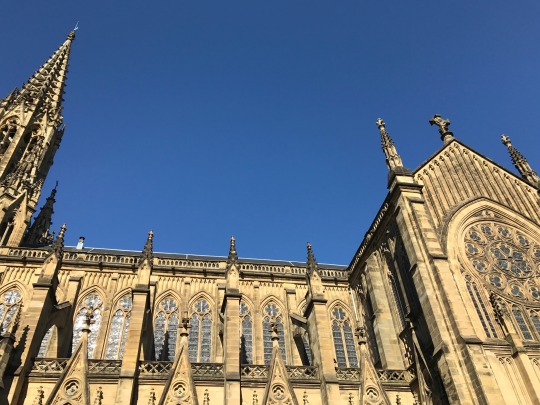

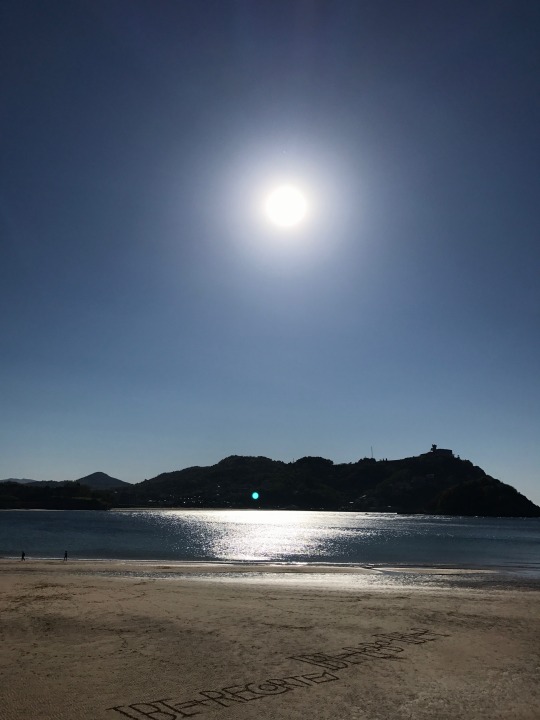
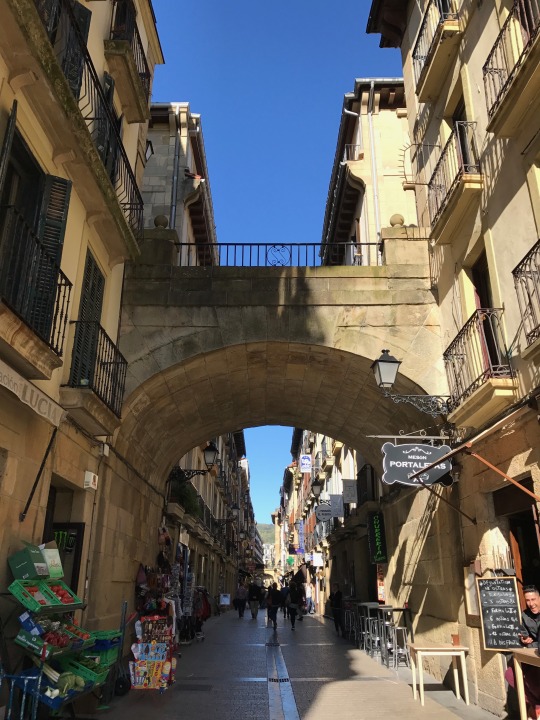

Basílica de Santa María del Coro
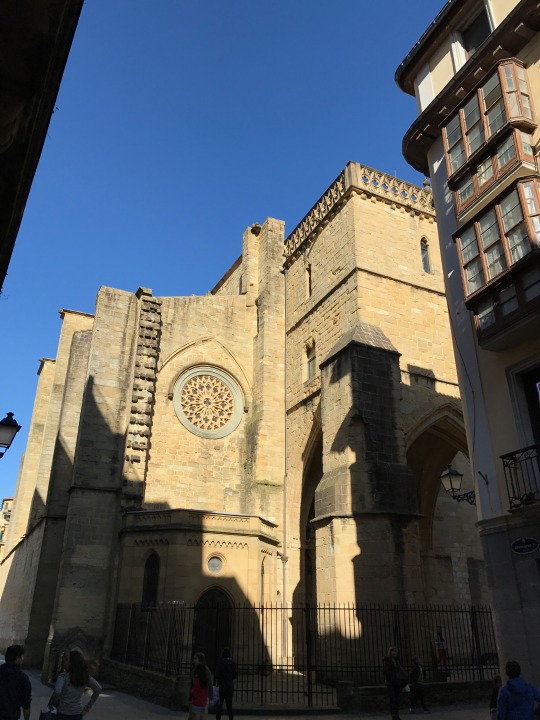
Iglesia San Vicente
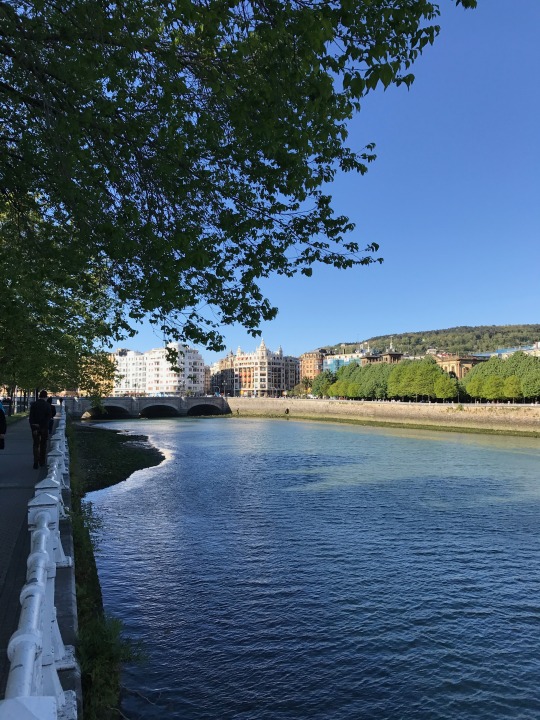
6. MADRID
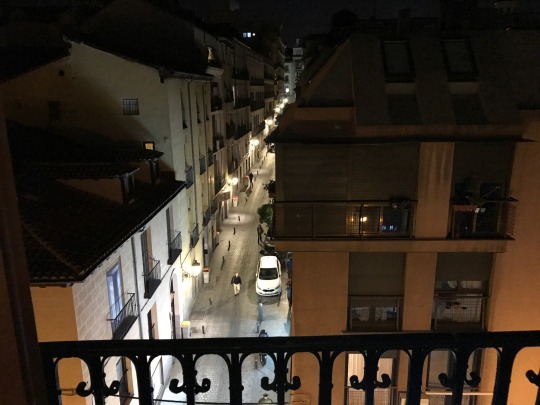
For the end of my two week traveling spree, I decided to splurge and treat myself a bit by booking a private single room in the cheapest hostel I could find in Madrid, instead of staying in a room in someone else’s house via AirBnb. This was the view from my balcony!

Because Madrid is the most globalized city in Spain, I was overjoyed to find a place where I could get a real, hearty American breakfast (breakfast in Spain is very, very light fare). It was so delicious (or maybe I had just missed real breakfast so much) that I ended up coming back here for breakfast again!

San Jerónimo el Real


Real Jardín Botánico
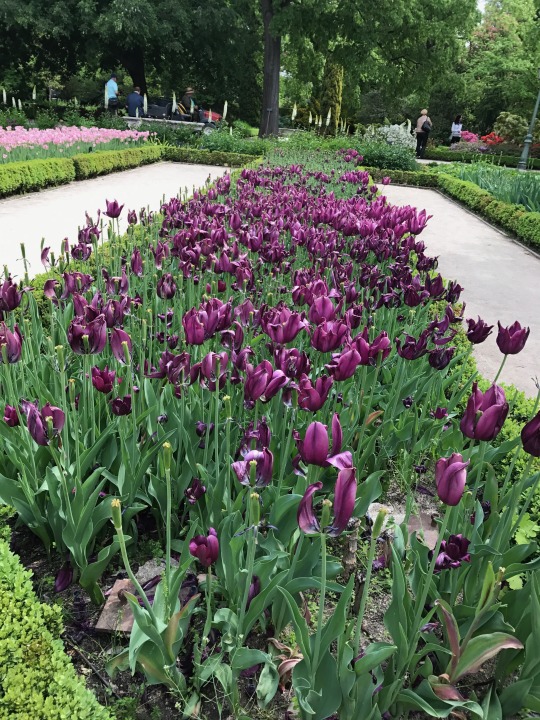




“I heard it and I forgot / I saw it and I understood / I did it and I learned.”
-Confucius

Parque de El Retiro

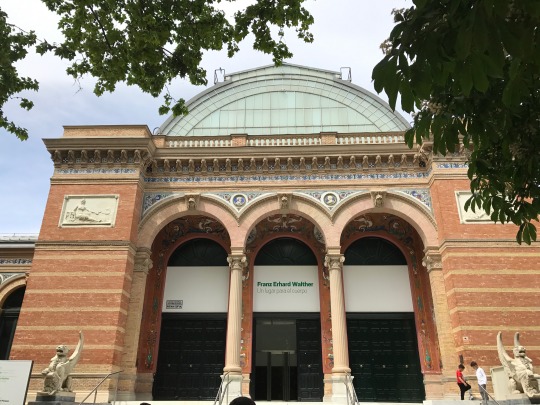



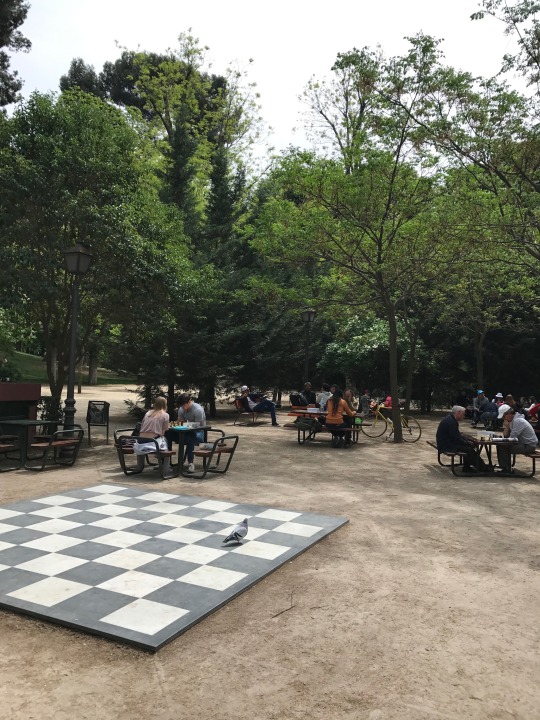
Cool spot in the park where you could rent a game of chess!

Puerta de Alcalá

Plaza de Cibeles. This building serves as the town hall of Madrid. Notice the “Refugees Welcome” banner - wishing our president could take a page out of Spain’s book.

Edificio Metrópolis along the Gran Vía

Estatua del Oso y el Madroño. This statue represents the Coat of Arms of Madrid and is also the 0 kilometer mark for all roads in Spain.

Estatua de Carlos III de España in the Puerta del Sol, the Spanish equivalent of Times Square.



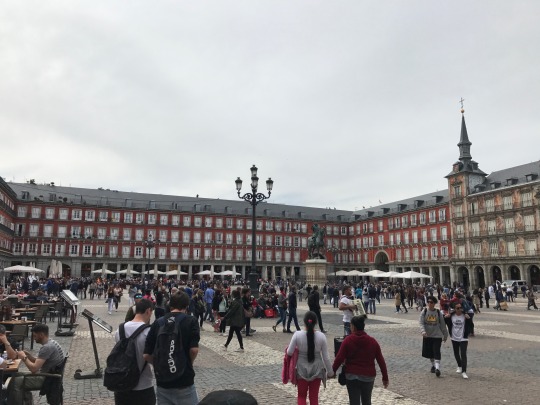
Plaza Mayor

Estatua de Felipe III de España
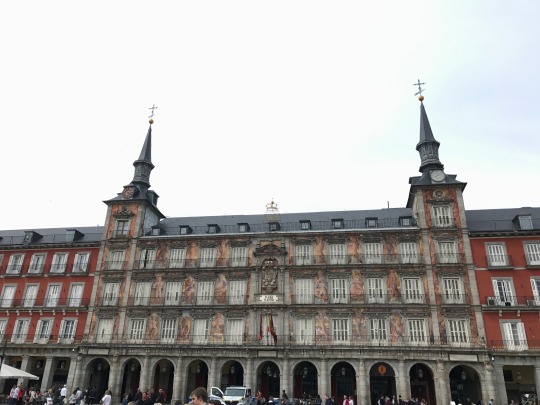





Real Basilica de San Francisco el Grande

Palacio Real de Madrid (Royal Palace of Madrid) seen from a distance.
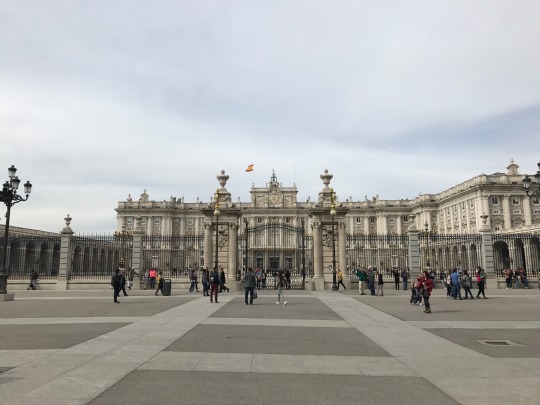
More pictures of the Palacio Real




Templo de Debod, a temple that was disassembled in Egypt and reassembled in Madrid, now located alongside a nice public park.


Biblioteca Nacional, the Spanish National Library

It’s really cool to me that Spain has a ministry (government department) of equality.
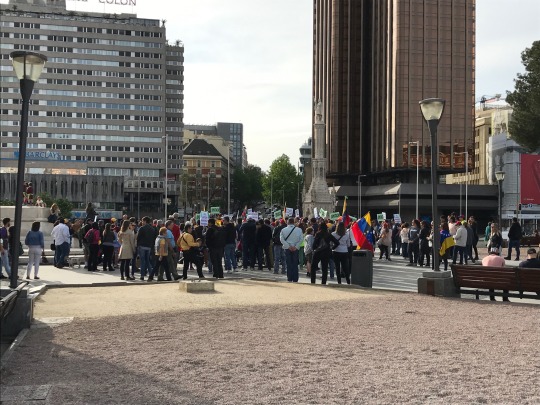
A protest by Venezuelan expats living in Spain, decrying political corruption in Venezuela and trying to raise awareness of their country’s economic crisis.
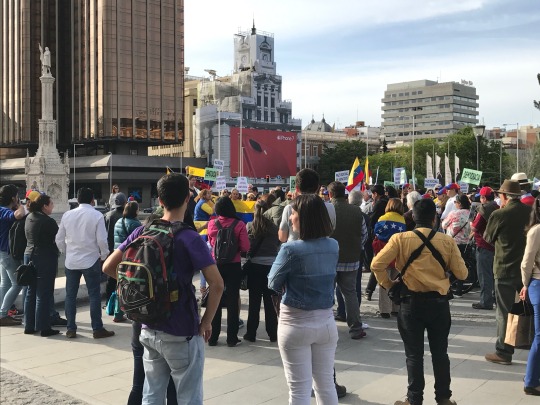

Las Bicicletas son para el verano (Bicycles are for Summer), a play I read for my Spanish Literature & Cinema class during the semester. I had the chance to see the play live in Madrid!
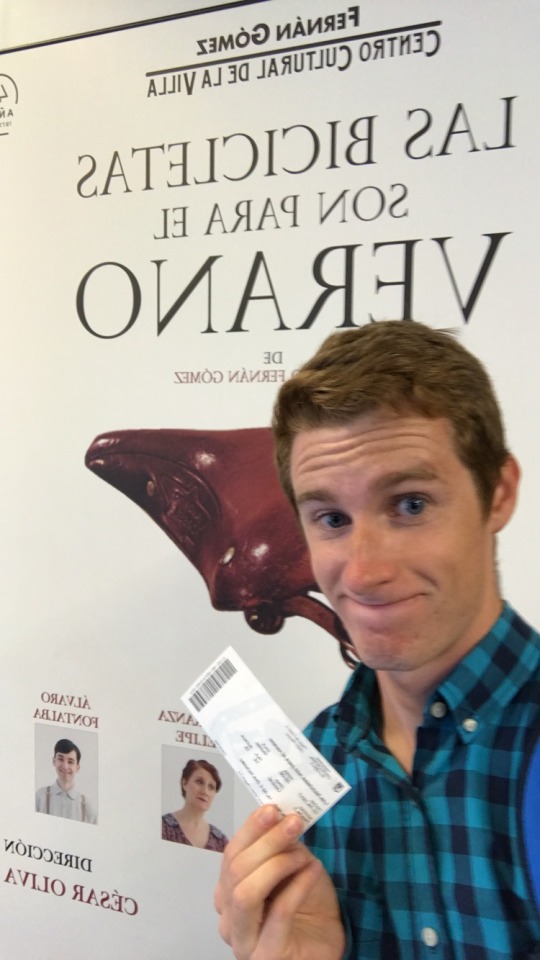

I was always taught it’s good to arrive to the theater a half-hour early, but here, the other spectators were living up to the stereotypes about Spanish punctuality.

Madrid at nighttime

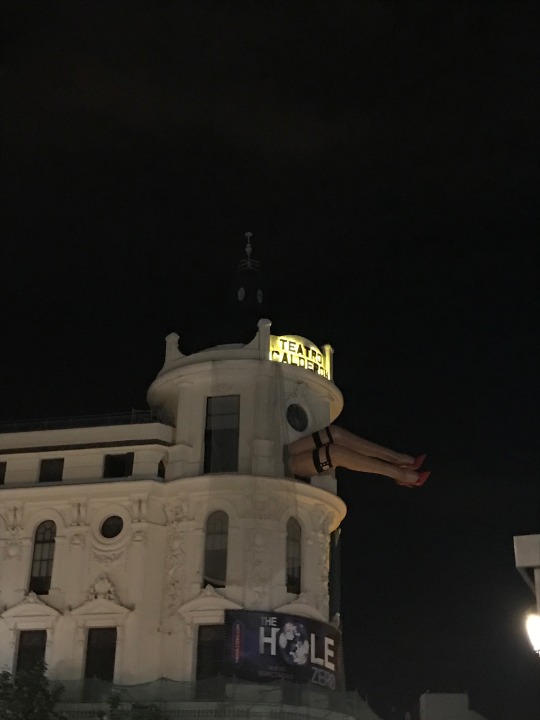
7. TOLEDO
The last stop on my two-week adventure was Toledo, Spain. The city had a very distinct charm and some absolutely incredible views of mountains and valleys.

I was already impressed with Toledo as soon as I stepped off the train - look at how how pretty the train station is!
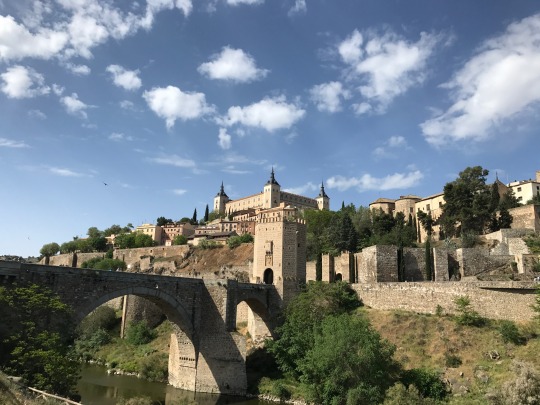
Puente de Alcántara
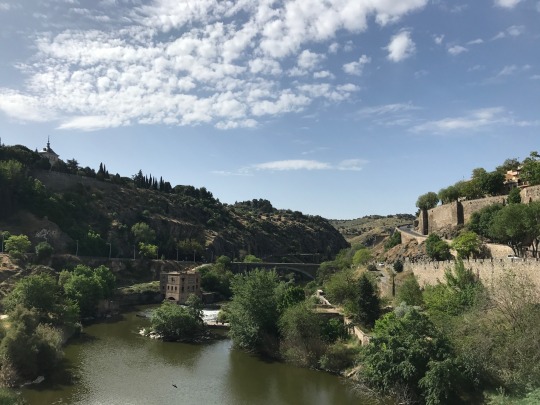
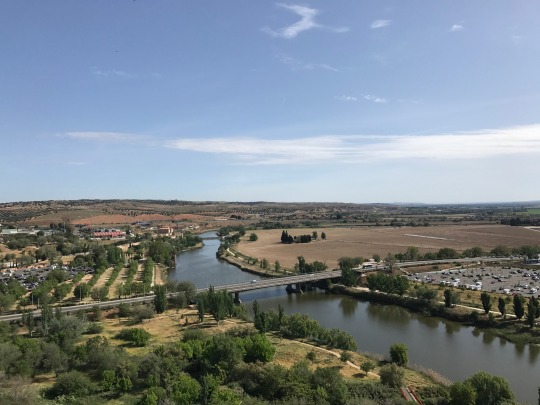


El Alcázar de Toledo

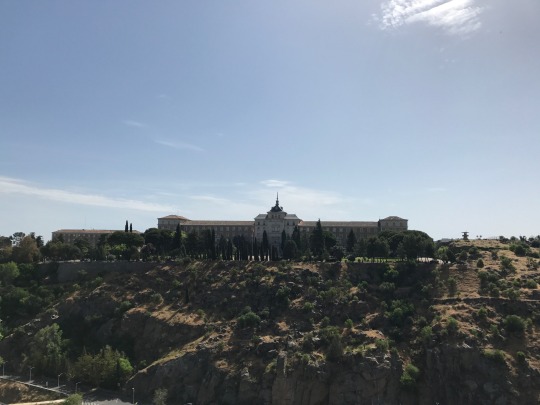
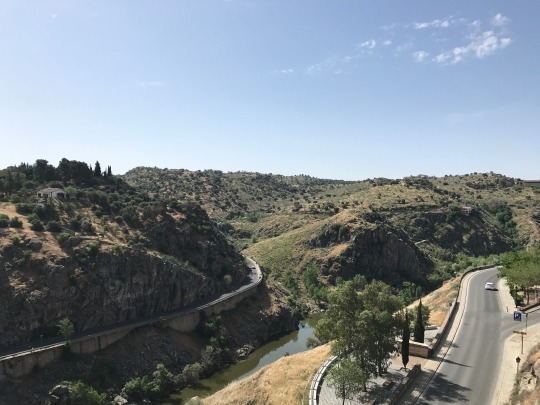
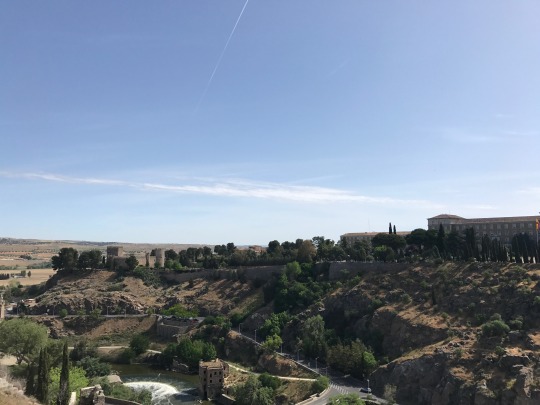

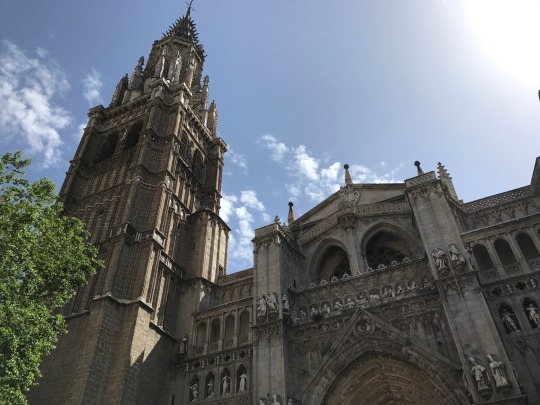
Catedral de Santa María de Toledo






Inside Monasterio de San Juan de los Reyes


Puerta de Bisagra
At this point, I took a very, veeeery roundabout hike (I didn’t really know what I was doing, I was just looking at the maps app on my phone) to try to find the Mirador del Valle, a lookout spot where you can see the whole city of Toledo in all its glory. It was a very hot, sweaty hike, but I finally made it, and the views were totally worth it.
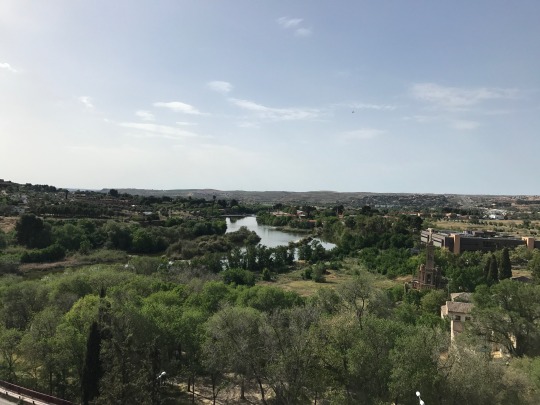




I also found another mini-mountain next to the lookout spot where I could get an even better vantage point of the city, so of course, I climbed it.
If you’ve reached this point in the post, you can smile as wide as I am in that last pic... you’re done! The never-ending blog post is finished. If you actually read all this, you deserve some award.
Although I was sad that my journey finally had to come to an end, upon my return to Valencia was greeted by my wonderful host mom, who stayed up until midnight to make sure I was well-received with a hot home-cooked meal (she’s the best).
This trip was very eye-opening for me in a lot of ways. It was an exercise in maturity to live independently for two weeks, not to mention the absolutely incredible opportunity to see so much of Spain in so little time. Even so, there are many more places I would have liked to visit. I’m already starting my list for round two. Spain, you haven’t seen the last of me!
0 notes
Video
youtube
Places to see in ( Tudela - Spain ) Tudela is a municipality in Spain, the second largest city of the autonomous community of Navarre and twice a former Latin bishopric. Tudela is sited in the Ebro valley. Fast trains running on two-track electrified railways serve Tudela and two freeways (AP 68 and AP 15) join close to it. Tudela is the capital of the Ribera Navarra, the agricultural region of lower Navarre. The poet Al-Tutili, the 12th-century traveler Benjamin of Tudela, the 13th century writer William of Tudela and the physician and theologian Michael de Villanueva were from the city. The city hosts an annual festival in honor of Santa Ana (mother of the Virgin Mary) which begin on 24 July at noon and continue for approximately a week. Street music, bullfights and the running of the bulls are typical events of the festival. Later Tudela became an important defensive point for the Kingdom of Navarre in battles with Castile and Aragon. Tudela was an Agramont party stronghold and actually the last Navarrese one to surrender to Ferdinand II of Aragon's Aragonese troops in the initial 1512 Spanish invasion of Navarre, only doing so to avoid futile bloodshed, Spanish pillaging and further confiscations to town dwellers, after the Navarrese king failed to send a relief force. At the end of the 17th century, a new public square was built, called Plaza Nueva or Plaza de los Fueros, which became the main city square. In 1783 the Diocese of Tudela was created, split off from Pamplona. On 23 November 1808, Napoleon Bonaparte's Marshal Lannes won the Battle of Tudela in the Peninsular War. The train station was built in 1861, which, together with the agricultural revolution, resulted in a new period of expansion for the city. The bishopric was merged back into 'Pamplona-Tudela' in 1851, restored in 1889 and ultimately suppressed in 1984. Alot to see in ( Tudela - Spain ) such as : The Cathedral of Our Lady of Solitude (12th-13th centuries). It includes examples of Romanesque architecture, such as the Puerta del Juicio, or Door of the (Last) Judgement, some Gothic influences and Baroque additions to the building. Church of Magdalene (12th century), in Romanesque style Church of San Nicolás (12th century) Church of San Jorge (17th century), in Baroque style Bardenas Reales Tudela Cathedral Museo Muñoz Sola de Arte Moderno Palacio Decanal El Dorado salón de juego y apuestas Santa María Magdalena, Tudela Casa del Almirante Bodegas García Burgos S L Nuevo Casino Tudelano Entidad Pública Empresarial Local Castel Ruiz Antonio Albiñana Martínez Plaza de los Fueros Museo Del Tudela ( Tudela - Spain ) is well know as a tourist destination because of the variety of places you can enjoy while you are visiting the city of Tudela . Through a series of videos we will try to show you recommended places to visit in Tudela - Spain Join us for more : https://www.youtube.com/channel/UCLP2J3yzHO9rZDyzie5Y5Og http://ift.tt/2drFR54 http://ift.tt/2cZihu3 http://ift.tt/2drG48C https://twitter.com/Placestoseein1 http://ift.tt/2cZizAU http://ift.tt/2duaBPE
0 notes
Text
Hyperallergic: The Vivid Violence and Divine Healing of Ex-Voto Paintings
Ex-voto oil painting for a man who was hit on the head by a falling flower pot in Rome (1890) (via Wellcome Images/Wikimedia)
The ex-voto painting is a tradition of folk art that acts as a tribute to divine intervention in personal calamities, as well as an inadvertent catalogue of human misfortune. The artworks cover everything from quotidian accidents, like a flower pot tumbling onto a well-dressed man’s head in 1890 Rome, to more shocking tragedies, such as a woman stabbed in her bed in 1934 Guadalajara, Mexico, and were commissioned as a sign of religious thanks.
While attached to the popular practice of Catholicism, ex-voto paintings developed from the votive ritual, which dates back to the ancient pagan beliefs of Rome, Mesopotamia, and Egypt. For instance, Egyptian archaeology has taught us about the act of leaving of animal mummies at sacred shrines, along with the fact that frequently these mummies were just animal shaped, containing nothing but rocks. Like the ex-voto paintings, they were personal petitions to the supernatural.
The “ex-voto” — Latin for, roughly, “from the vow” — isn’t always a painting. In the small Saint Roch Chapel in New Orleans, plaster limbs and hearts have accumulated as signs of healing prayers answered. At Saint Joseph’s Oratory in Montreal, symbolic crutches and canes are stacked to the ceiling, left by individuals in gratitude for cures. The walls of the Basilique Notre-Dame-des-Victoires in Paris are covered with the repeating word “merci,” or “thanks,” on tablets. The ex-voto paintings are different, however, in being narrative, each telling a completely unique tale of woe.
German ex-voto for a woman’s fall from a ladder (1882) (via Bayerisches Nationalmuseum/Wikimedia)
According to Michael P. Carroll’s Madonnas That Maim: Popular Catholicism in Italy Since the Fifteenth Century, the practice of installing ex-voto art in Catholic sanctuaries likely began in Italy, gaining prominence in the 16th century and then spreading around Europe. The ex-voto traveled with French colonists to Canada and with Spanish colonists to Mexico. Gloria Fraser Giffords writes in Mexican Folk Retablos that in “the colonial epoch and until the end of the eighteenth century the offering of votive pictures was almost wholly confined to the wealthy.” Following Mexican independence from Spain, “the common man adopted the ex-voto for his own.”
In 19th-century Mexico, the content of ex-votos stayed the same — a depiction of the accident, illness, or misfortune in question, along with the intervening saint or other heavenly presence — but the materials changed. There were fewer canvases and more works on tin. Rather than meticulous, idealized scenes, ex-votos became theatrical and free-form, often created by self-taught artists. By the 20th century, contemporary artists were drawn to this dramatic folk art. Alexxa Gotthardt at Artsy recently described how Diego Rivera and Frida Kahlo collected Mexican votive paintings, many of which are now on view in the Museo Frida Kahlo in Mexico City. Kahlo owned over 400 ex-voto paintings, and one of a woman who survived being stabbed in bed is said to have inspired her bloody 1935 “A Few Small Nips.”
A 1934 ex-voto from Guadalajara, Mexico, that appears to show a person being stabbed and is dedicated to the Virgin of Talpa in thanks for survival. It’s believed to have inspired Frida Kahlo’s work “A Few Small Nips.” (via Museo Frida Kahlo/Wikimedia)
Ex-votos are also a record of centuries of disease and historic treatments, a subject that the US National Library of Medicine explores in an online exhibition of medical imagery. Claire Voon wrote for Hyperallergic about an 18th-century ex-voto at the Davis Museum of Wellesley College which is one of the earliest depictions of a mastectomy. The diminutive, detailed artwork that shows blood spewing from a serene patient was once owned by surrealist André Breton.
Today, the tradition has mostly been replaced by mass-produced, symbolically shaped milagros and photographs, yet it does endure. Barry Nemett wrote an essay for Hyperallergic on visiting the Santuario della Madonna dei Bagni in Casalina, Italy, where hundreds of painted tiles dating from 1657 to the present represent everything from demonic possession to concentration-camp internment. Below, you can see international examples of ex-voto paintings from across the centuries. They capture falls from ladders, gun accidents, animal attacks, car crashes, fires, and avalanches, each with the Virgin Mary or another spiritual force emerging on the scene like a divine superhero to save the day.
Ex-voto to Mary for the protection of geese, from lower Bavaria (1839) (via Germanisches Nationalmuseum/Wikimedia)
Votive tablets in the Church of Santa Marie de Bagni, Deruta, Italy (via Wellcome Images/Wikimedia)
Votive paintings and offerings on the walls at the back of the chapel at Gnadenkapelle, Altötting, Bavaria, Germany (photo by Mattana/Wikimedia)
Ex-voto paintings in the Sanctuary of Chalma in Chalma, Malinalco, Mexico (2009) (photo by Thelmadatter/Wikimedia)
Ex-voto oil on copper foil painting to Lord Saint Joseph from a Mexican man who was imprisoned (1924) (via Museo Frida Kahlo/Wikimedia)
Ex-voto in thanks for surviving surgery in the Sanctuary of Chalma in Chalma, Malinalco, Mexico (1960s) (photo by Thelmadatter/Wikimedia)
Votive painting for surviving a car wreck at the Sanctuary of Chalma in Chalma, Malinalco, Mexico (photo by Thelmadatter/Wikimedia)
Votive offering to the Lord of the Encino (1865) (via Museo Frida Kahlo/Wikimedia)
Ex-voto oil painting of a boy who fell under the wheel of an ox cart. P. G. R. stands for “Per Grazia Ricevuta,” or “For Grace Received.” (via Wellcome Library)
Ex-voto for a lighting strike (1957) (photo by Andrés Marín Jarque, via Museu Valencià d’Etnologia/Wikimedia)
Ex-voto painted by B. Pistoni of a patient with her two attendants and a physician (1872) (via Wellcome Library)
Ex-voto for surviving an avalanche in Austria (1817) (via Vorarlberg Museum/Wikimedia)
Votive offering dedicated to Our Lady of Solitude (1886) (via Museo Frida Kahlo/Wikimedia)
Votive offering dedicated to the Three Wisdom Kings (1928) (via Museo Frida Kahlo/Wikimedia)
Italian ex-voto painting of two women attending to a man in bed and appealing to Sansovino’s Virgin and Child (1888) (via Wellcome Library)
Mexican ex-voto oil on copper painting to San Nicolás de Tolentino depicting a carriage accident (1936) (via Museo Frida Kahlo/Wikimedia)
Ex-voto on wood for a gun accident in Santa Maria in Portuno, Italy (1892) (via Giuseppe.lepore4/Wikimedia)
Mexican ex-voto oil on copper foil painting dedicated to the Lord of Mercy from a woman injured by an animal (1876) (via Museo Frida Kahlo/Wikimedia)
Ex-voto for a truck accident (photo by Andrés Marín Jarque, via Museu Valencià d’Etnologia/Wikimedia)
Votive offering dedicated to San Nicolás de Tolentino (1938) (via Museo Frida Kahlo/Wikimedia)
Ex-voto for an accident from Southern Germany (1825) (via Germanisches Nationalmuseum/Wikimedia)
Austrian ex-voto in the Liebfrauenkirche Kitzbühel for an accident with a bell (1849) (via Uoaei1/Wikimedia)
Ex-voto for a cart accident (1843) (via Hampel Kunstauktionen/Wikimedia)
Ex-votofrom Tuscany for a man who survived being caught on fire (via Sailko/Wikimedia)
Ex-voto for Our Lady of San Juan de los Lagos, Mexico, from a man attacked on the street (1938) (via Tropenmuseum Amsterdam/Wikimedia)
Votive painting for Our Lady of San Juan de los Lagos, Mexico, for surviving an animal attack (1912) (photo by Andreas Praefcke/Wikimedia)
Ex-voto of a deer injury in Santuario della Madonna di San Romano, Montopoli in Val d’Arno, Italy (photo by Sailko/Wikimedia)
Ex-voto for an accident in the Museo Adriano Bernareggi (1928) (photo by Sailko/Wikimedia)
Ex-voto oil on canvas painting of a ship in distress (1794) (via Städtisches Museum Überlingen/Wikimedia)
Ex-voto for an Italian man named Luigi Cobai who survived a fall (1902) (photo by Jean-Marc Pascolo/Wikimedia)
The post The Vivid Violence and Divine Healing of Ex-Voto Paintings appeared first on Hyperallergic.
from Hyperallergic http://ift.tt/2iYzx4G via IFTTT
0 notes